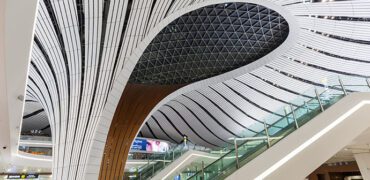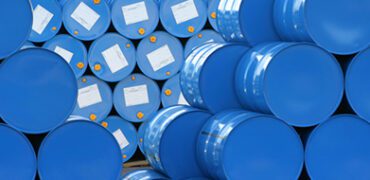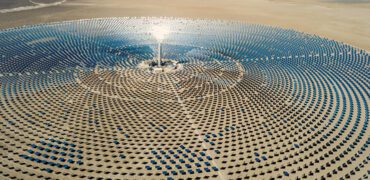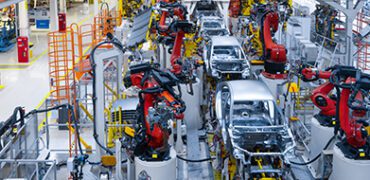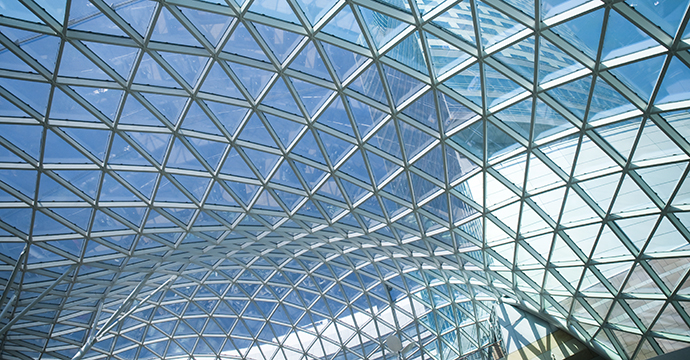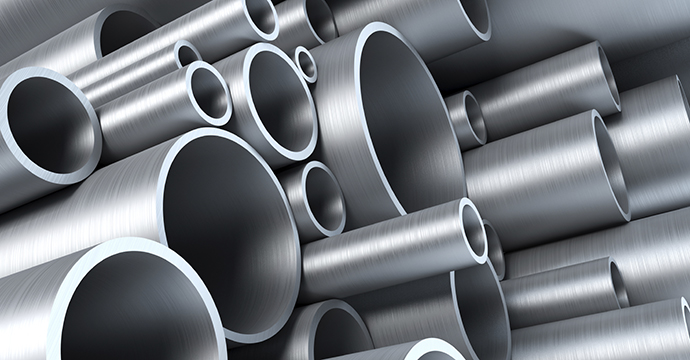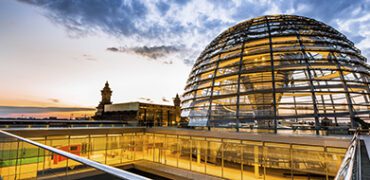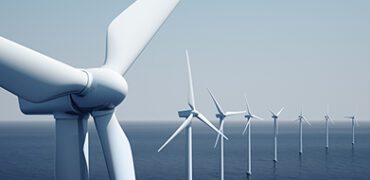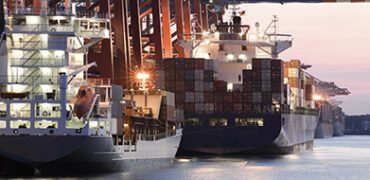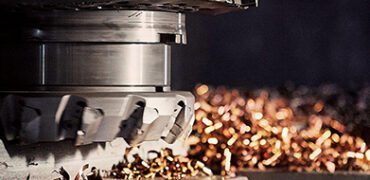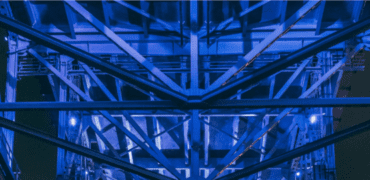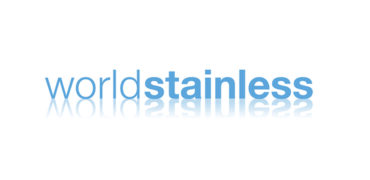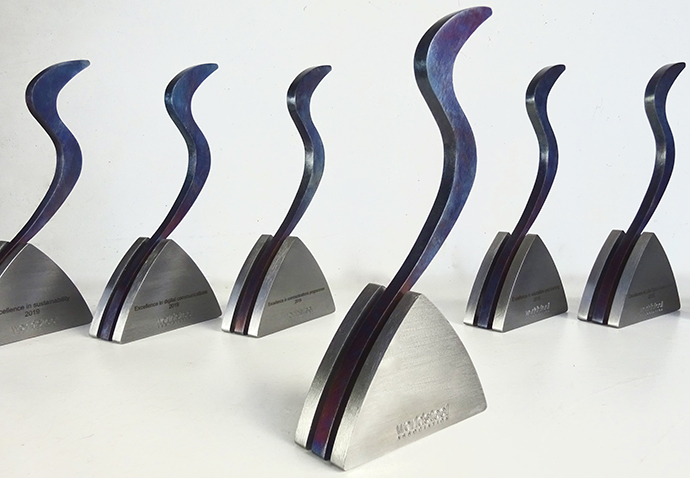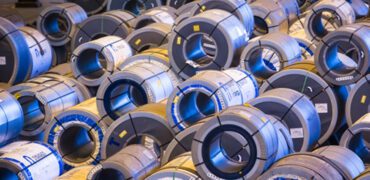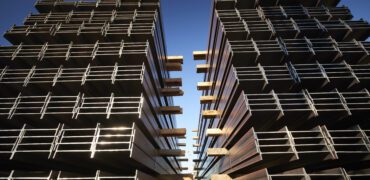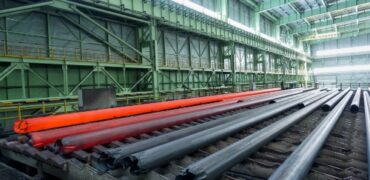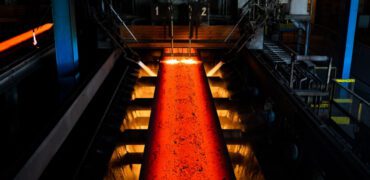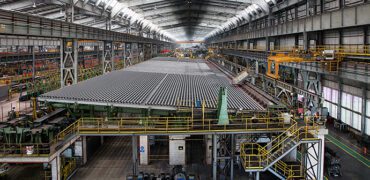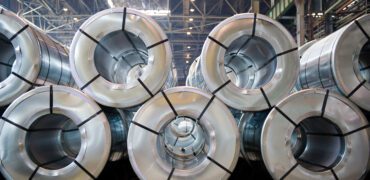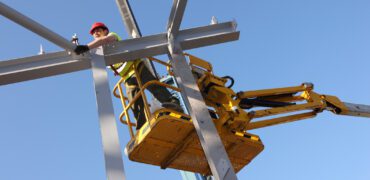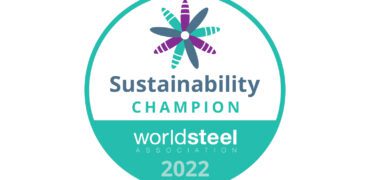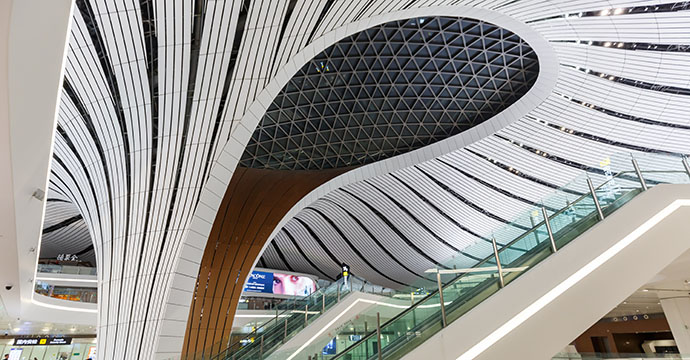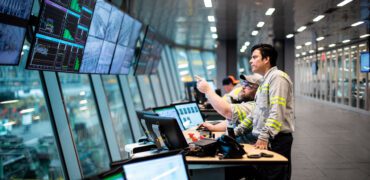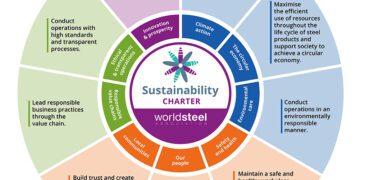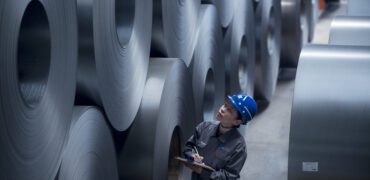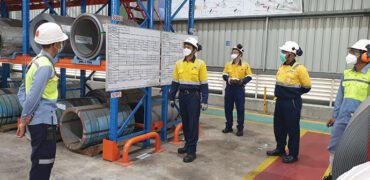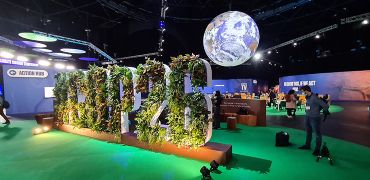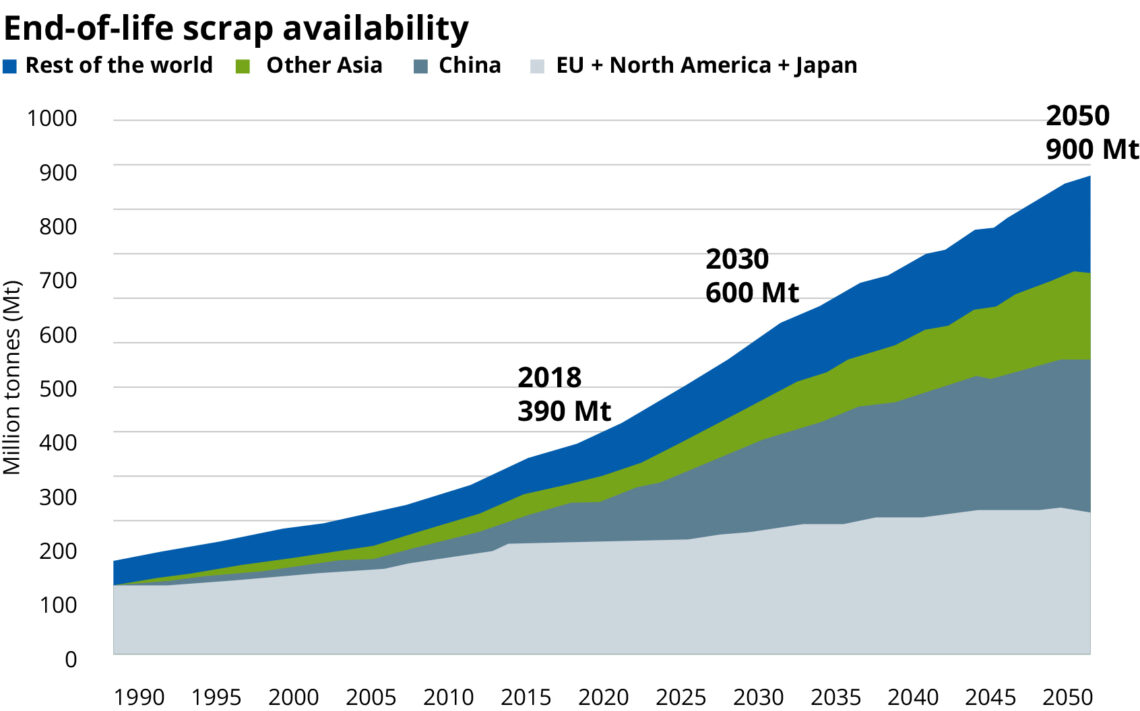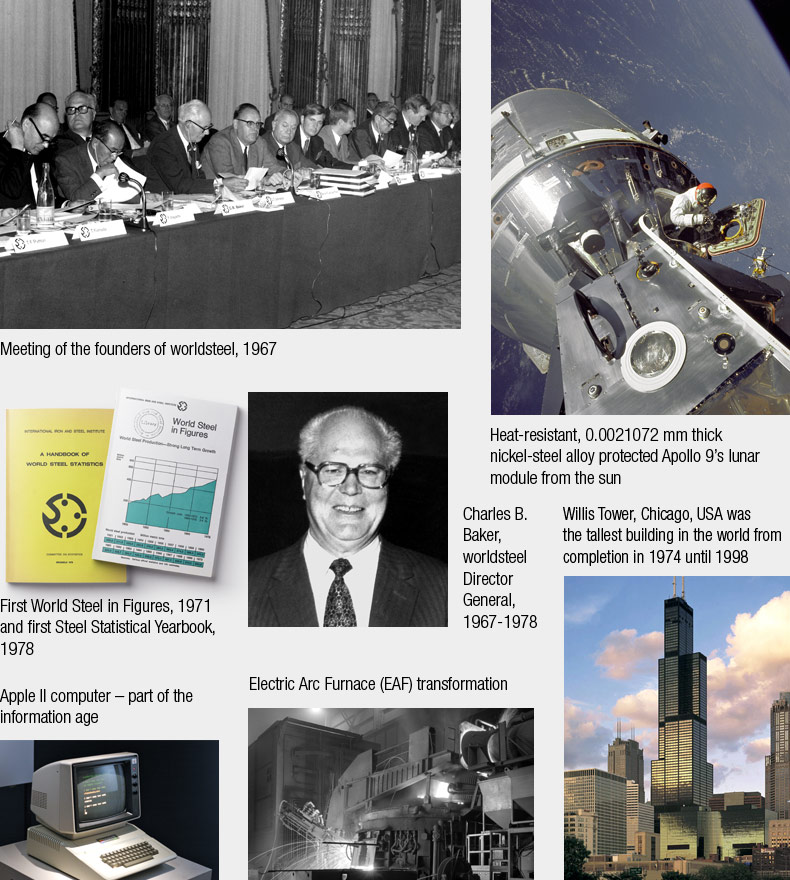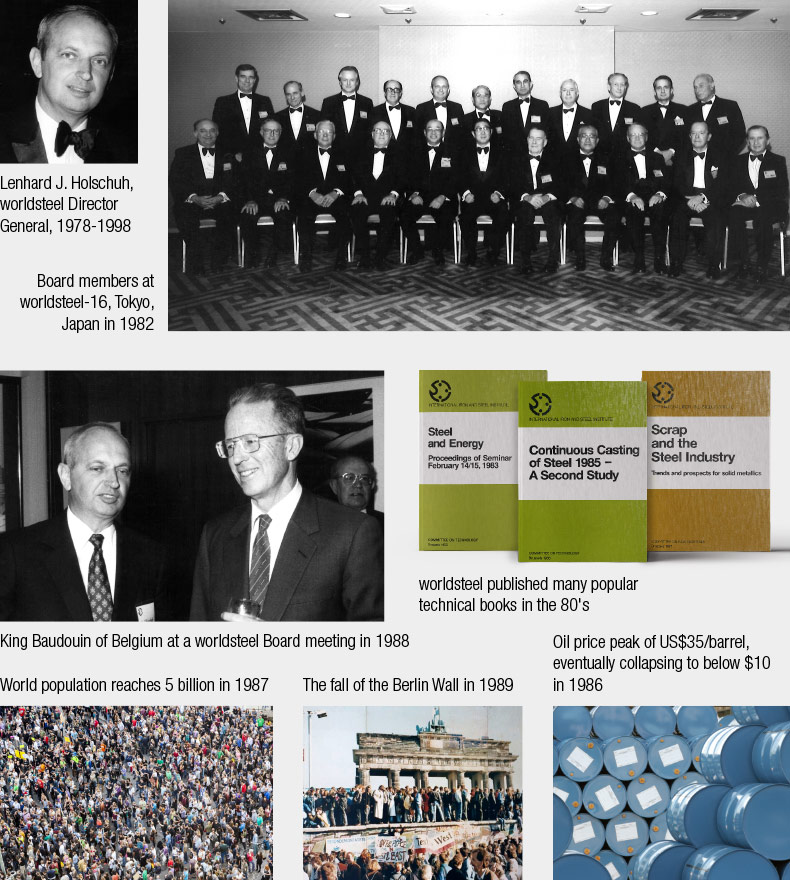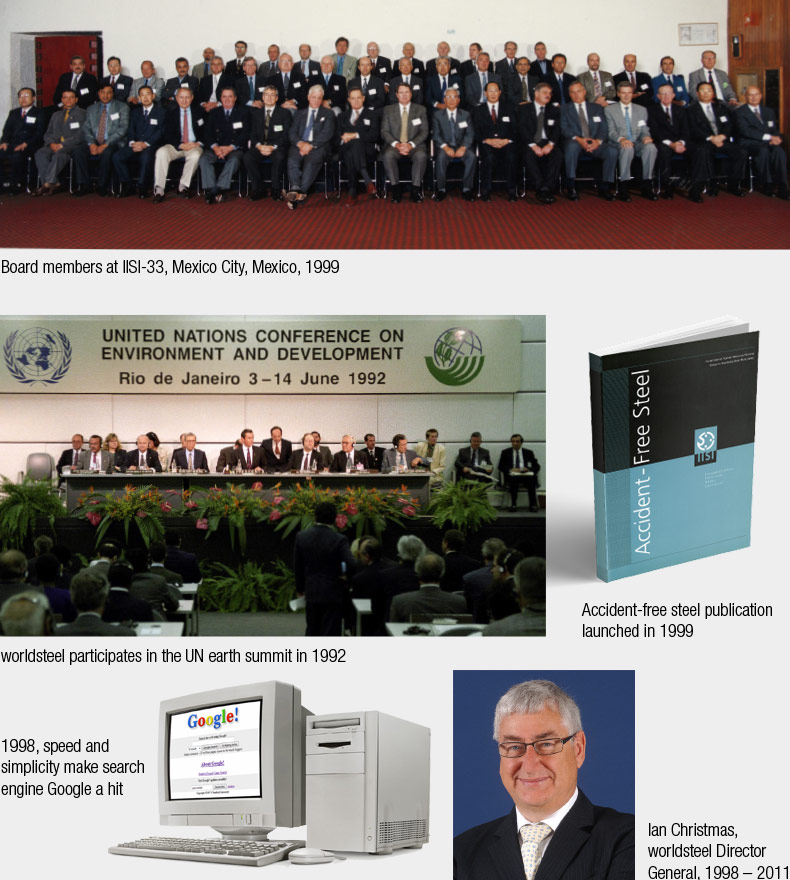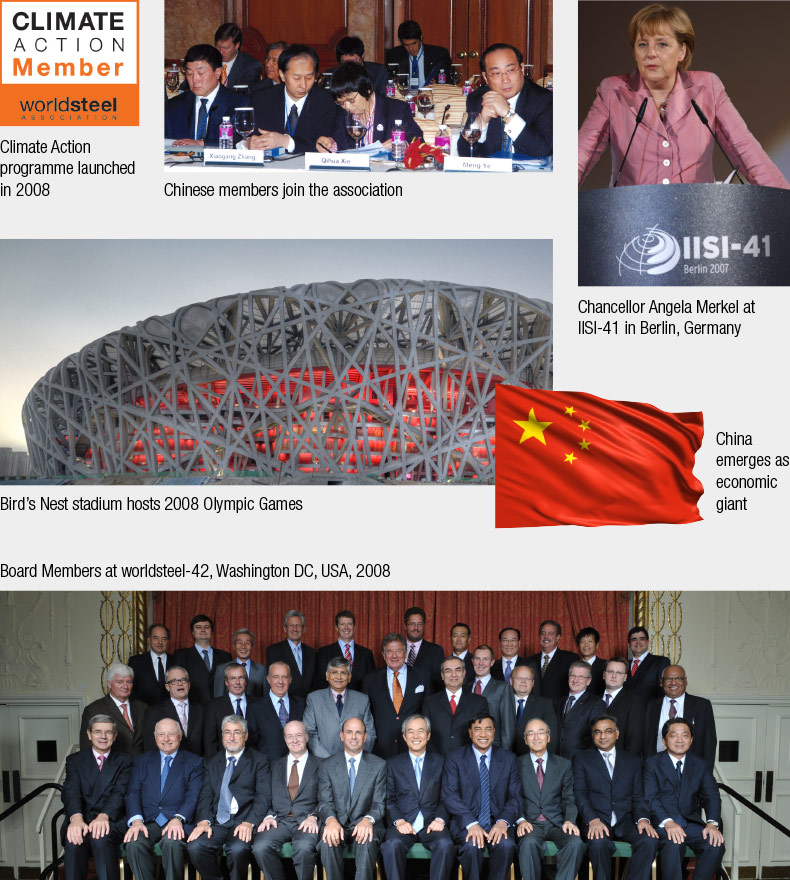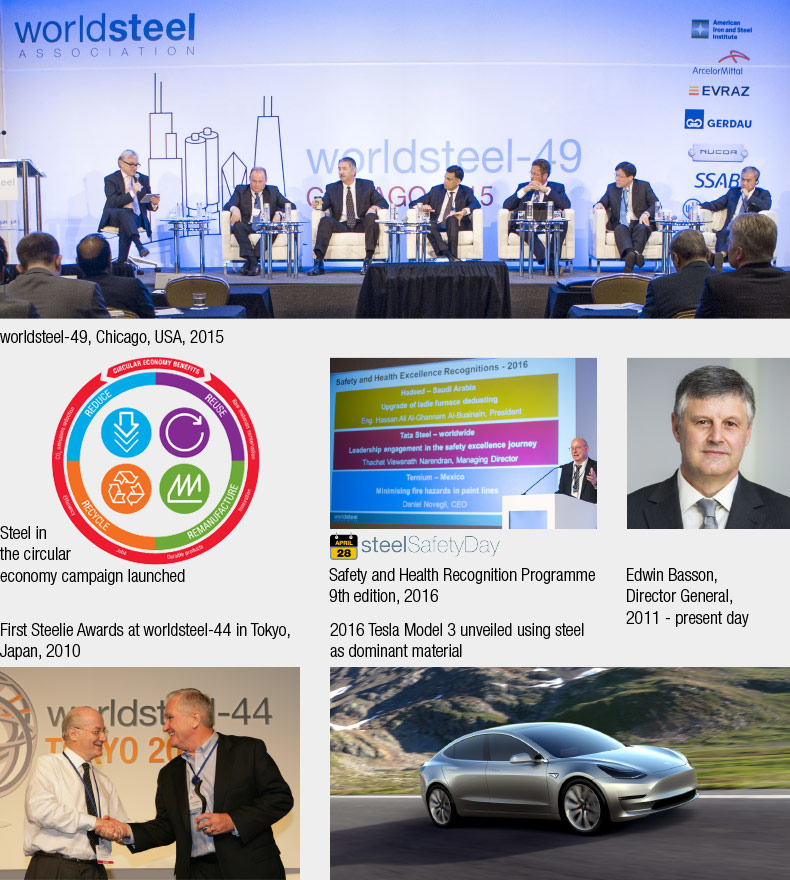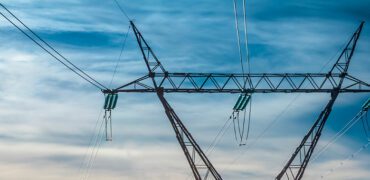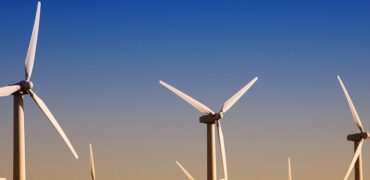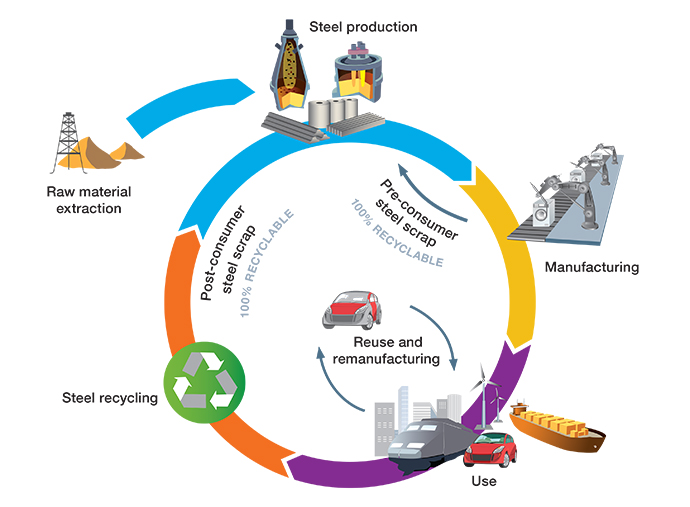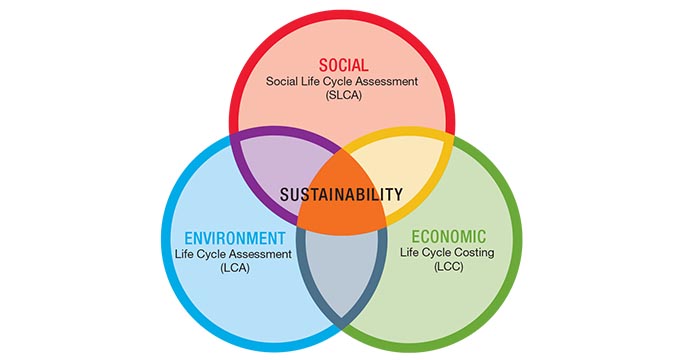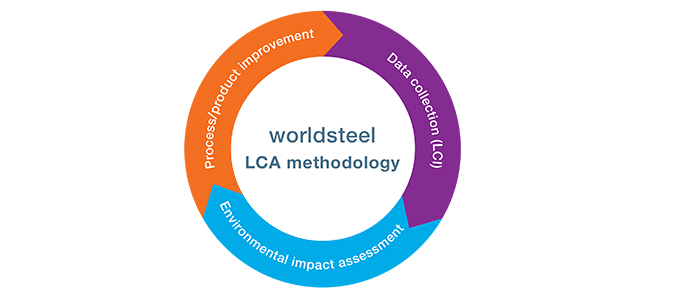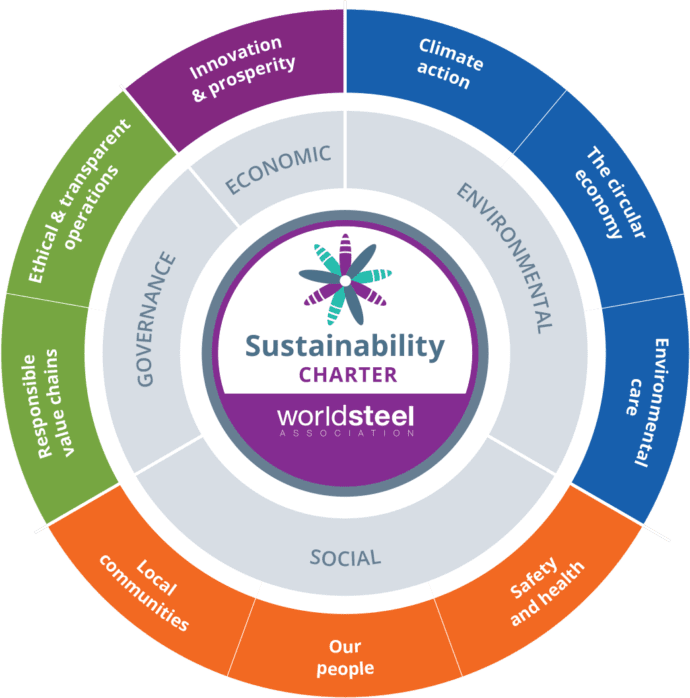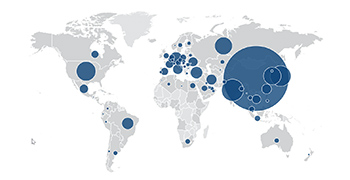World steel association
World steel association
2020 Press Releases
November 2020 crude steel production
World crude steel production for the 64 countries reporting to the World Steel Association (worldsteel) was 158.3 million tonnes (Mt) in November 2020. Read more
2020 Steel Statistical Yearbook published
The World Steel Association (worldsteel)’s Steel Statistical Yearbook presents a cross-section of steel industry statistics. It contains comprehensive statistics from 2010 to 2019 on crude steel production by country and process. Read more
worldsteel announces steelChallenge-15 World Championship Finalists
The Regional Championship took place online for 24 hours on 25 November 2020. This year’s steelChallenge attracted over 1200 participants. Read more
October 2020 crude steel production
World crude steel production for the 64 countries reporting to the World Steel Association (worldsteel) was 161.9 million tonnes (Mt) in October 2020. Read more
Sustainable steel – Indicators 2020 and steel applications
New Steel Industry Engineering Program Will Demonstrate Steel Architectures for MaaS Vehicles
Characterized by fully connected and autonomous electric vehicles. Read more
The steel industry in modern society
worldsteel Director General Edwin Basson presents at the Global Forum on Steel Excess Capacity (GFSEC) Ministerial meeting on 26 October 2020. Read more
September 2020 crude steel production
World crude steel production for the 64 countries reporting to the World Steel Association (worldsteel) was 156.4 million tonnes (Mt) in September 2020, a 2.9% increase compared to September 2019. Read more
Steel Safety Day and Safety and Health Recognition 2020
Today is Steel Safety Day, a day for worldsteel and its member companies to pause and dedicate their attention to the industry’s most important priority. Read more
worldsteel Short Range Outlook October 2020
The World Steel Association (worldsteel) today released an update to its Short Range Outlook (SRO) for 2020 and 2021. This SRO is showing a much more optimistic outlook than the previous SRO finalised in June. Read more
The 11th Steelie Award winners announced
The winners of the 11th Steelie Awards were announced on 14 October 2020. Read more
worldsteel elects new officers and welcomes new members
The Board of Members of the World Steel Association (worldsteel) has elected the Executive Board of Directors for the 2020/2021 period and has welcomed new members. Read more
11th Steelie Awards shortlist announced
The World Steel Association (worldsteel) has announced the shortlist for the 11th Steelie Awards. The Steelie Awards recognise member companies or individuals for their contribution to the steel industry over a one-year period in a series of categories impacting the industry. Read more
August 2020 crude steel production
World crude steel production for the 64 countries reporting to the World Steel Association (worldsteel) was 156.2 million tonnes (Mt) in August 2020, a 0.6% increase compared to August 2019. Read more
steelChallenge-15 registration open
steelChallenge is the world’s biggest steel industry competition. Read more
July 2020 crude steel production
World crude steel production for the 64 countries reporting to the World Steel Association (worldsteel) was 152.7 (Mt) in July 2020, a 2.5% decrease compared to July 2019. Read more
June 2020 crude steel production
World crude steel production for the 64 countries reporting to the World Steel Association (worldsteel) was 148.3 million tonnes (Mt) in June 2020, a 7.0% decrease compared to June 2019. Read more
May 2020 crude steel production
World crude steel production for the 64 countries reporting to the World Steel Association (worldsteel) was 148.8 million tonnes (Mt) in May 2020, an 8.7% decrease compared to May 2019. Read more
worldsteel Short Range Outlook June 2020
worldsteel today released its Short Range Outlook (SRO) for 2020 and 2021. In 2020 worldsteel forecasts that steel demand will contract by 6.4% due to the COVID-19 crisis. Read more
worldsteel announces the 2019 Steel Sustainability Champions
The World Steel Association (worldsteel) has recognised 9 companies as Steel Sustainability Championsfor their work in 2019. Read more
April 2020 crude steel production
World crude steel production for the 64 countries reporting to the World Steel Association (worldsteel) was 137.1 million tonnes (Mt) in April 2020, a 13.0% decrease compared to April 2019. Read more
March 2020 crude steel production
World crude steel production for the 64 countries reporting to the World Steel Association (worldsteel) was 147.1 million tonnes (Mt) in March 2020, a 6.0% decrease compared to March 2019. Read more
worldsteel announces the World Champions of steelChallenge-14
The World Steel Association (worldsteel) today announced the new world champions of the 14th steelChallenge. Read more
Interim steel demand economic statement
worldsteel has today published its interim steel demand economic statement in advance of its full Short Range Outlook (SRO) press release to be issued in June. Read more
April 2020 SRO postponement and other updates
In light of the unprecedented disruptions of the COVID-19 pandemic, worldsteel has taken the decision not to publish its April Short Range Outlook (SRO) for steel demand this month. Read more
February 2020 crude steel production
World crude steel production for the 64 countries reporting to the World Steel Association (worldsteel) was 142.4 million tonnes (Mt) in February 2020, a 2.1% increase compared to February 2019. Read more
January 2020 crude steel production
World crude steel production for the 64 countries reporting to the World Steel Association (worldsteel) was 154.4 million tonnes (Mt) in January 2020, a 2.1% increase compared to January 2019. Read more
Global crude steel output increases by 3.4% in 2019
Global crude steel production reached 1,869.9 million tonnes (Mt) for the year 2019, up by 3.4% compared to 2018. Crude steel production contracted in all regions in 2019 except in Asia and the Middle East. Read more
World steel association
Avenue de Tervueren 270
B-1150 Bruxelles
Belgium
Рабочие связи
| Ссылка | Заголовок | Тип |
|---|---|---|
| ISO/TC 17 | Steel | A |
| ISO/TC 59/SC 17 | Sustainability in buildings and civil engineering works | A |
| ISO/TC 207 | Environmental management | A |
| ISO/TC 207/SC 1 | Environmental management systems | A |
| ISO/TC 207/SC 2 | Environmental auditing and related environmental investigations | A |
| ISO/TC 207/SC 4 | Environmental performance evaluation | A |
| ISO/TC 207/SC 5 | Life cycle assessment | A |
| ISO/TC 207/SC 7 | Greenhouse gas and climate change management and related activities | A |
| ISO/TC 323 | Circular economy | A |
Примечания
Liaisons A: Organizations that make an effective contribution to the work of the technical committee or subcommittee for questions dealt with by this technical committee or subcommittee.
Liaisons B: Organizations that have indicated a wish to be kept informed of the work of the technical committee or subcommittee.
Liaisons C: Organizations that make a technical contribution to and participate actively in the work of a working group.
Когда мировое сообщество достигает консенсуса
Мы гарантируем доступ к нашему сайту каждому. Если у вас возникли вопросы или предложения, касающиеся доступа к данной странице, пожалуйста свяжитесь с нами.
Steel Statistics
About our statistics
Our statistics and subscriptions
Steel Data Viewer
Monthly crude steel production
Annual steel data
Production, trade, and use
Short Range Outlook
Steel demand forecast
Top steel producers
List of steel producers by tonnage
Data reports
Steel statistical publications
Steel impact
Steel industry social and economic impact
World Steel Association AISBL
Registered office:
Avenue de Tervueren 270 – 1150 Brussels – Belgium
T: +32 2 702 89 00 – F: +32 2 702 88 99 – E: steel@worldsteel.org
Beijing office
C413 Office Building – Beijing Lufthansa Center – 50 Liangmaqiao Road
Chaoyang District – Beijing 100125 – China
T: +86 10 6464 6733 – F: +86 10 6468 0728 – E: china@worldsteel.org
worldsteel news
Sign up to receive our e-newsletter.
You can easily unsubscribe at any time.
Governance
The work of the World Steel Association (worldsteel) is guided by its members and overseen by its Executive Board of Directors.
The Executive Board of Directors is supported by an elected Executive Committee as well as by the Audit Committee and Nominating Committee. All worldsteel officers, including the Chairman and members of those Committees are elected during the general meetings of members under the advisement of the Nominating Committee.
Main member representatives of Regular and Affiliated members (referred to as Board of Members) can participate and vote during the general meeting of members. Each member has at least one vote and additional voting rights are set in Article 2 of the Internal Regulations of worldsteel.
Day to day operations of the association are administered by a Director General, who is appointed by the Executive Board. worldsteel’s current Director General is Edwin Basson.
2021-2022 Office Bearers
The following office bearers were elected for a one-year term in October 2021.
Chairman
Sajjan JINDAL JSW Steel Limited
Vice Chairman
Jeong-Woo CHOI, POSCO
Vice Chairman
Yong YU, HBIS Group Co., Ltd.
Treasurer
Mark VASSELLA, BlueScope Steel Limited
Chairperson of the International Stainless Steel Forum (ISSF)
Timoteo DI MAULO, Aperam
The Board of Members has also elected the 2021/2022 Executive Committee:
Membership
The World Steel Association (worldsteel) is one of the largest and most dynamic industry associations in the world, with members in every major steel-producing country. worldsteel represents steel producers, national and regional steel industry associations, and steel research institutes. Members represent around 85% of global steel production.
Membership has increased steadily since worldsteel (formerly the International Iron and Steel Institute) was founded in 1967.
worldsteel’s mission is to:
Who can become a member?
There are 2 categories of worldsteel membership:
As a member you will be able to:
The association exerts no pressure or politics on its members. worldsteel is not involved in competitive issues between steel companies.
Who we are
The World Steel Association (worldsteel) is a non-profit organisation with headquarters in Brussels, Belgium. A second office in Beijing, China, opened in April 2006.
worldsteel is one of the largest and most dynamic industry associations in the world, with members in every major steel-producing country. worldsteel represents steel producers, national and regional steel industry associations, and steel research institutes. Members represent around 85% of global steel production.
It was founded as the International Iron and Steel Institute on 10 July 1967. It changed its name to the World Steel Association on 6 October 2008. The association celebrated its 50th anniversary in 2017.
Our goals
Our activities
To find out more, click here.
Our relationship with international organisations
worldsteel maintains relations with several international organisations, including:
Our history
1967
1970s
1980s
1990s
2000s
2010s
About steel
Steel is the world’s most important engineering and construction material. It is used in every aspect of our lives; in cars and construction products, refrigerators and washing machines, cargo ships and surgical scalpels. It can be recycled over and over again without loss of property.
What is steel?
Iron is made by removing oxygen and other impurities from iron ore. When iron is combined with carbon, recycled steel and small amounts of other elements it becomes steel.
Steel is an alloy of iron and carbon containing less than 2% carbon and 1% manganese and small amounts of silicon, phosphorus, sulphur and oxygen.
Steel is the world’s most important engineering and construction material. It is used in every aspect of our lives; in cars and construction products, refrigerators and washing machines, cargo ships and surgical scalpels.
How is steel made?
Steel is produced via two main routes: the blast furnace-basic oxygen furnace (BF-BOF) route and electric arc furnace (EAF) route. Variations and combinations of production routes also exist.
The key difference between the routes is the type of raw materials they consume. For the BF-BOF route these are predominantly iron ore, coal, and recycled steel, while the EAF route produces steel using mainly recycled steel and electricity. Depending on the plant configuration and availability of recycled steel, other sources of metallic iron such as direct-reduced iron (DRI) or hot metal can also be used in the EAF route.
A total of around 70% of steel is produced using the BF-BOF route. First, iron ores are reduced to iron, also called hot metal or pig iron. Then the iron is converted to steel in the BOF. After casting and rolling, the steel is delivered as coil, plate, sections or bars.
Steel made in an EAF uses electricity to melt recycled steel. Additives, such as alloys, are used to adjust to the desired chemical composition. Electrical energy can be supplemented with oxygen injected into the EAF. Downstream process stages, such as casting, reheating and rolling, are similar to those found in the BF-BOF route. About 30% of steel is produced via the EAF route.
Another steelmaking technology, the open hearth furnace (OHF), makes up about 0.4% of global steel production. The OHF process is very energy-intensive and is in decline owing to its environmental and economic disadvantages.
More details relating to the data above is available from our Steel Statistical Yearbook.
Most steel products remain in use for decades before they can be recycled. Therefore, there is not enough recycled steel to meet growing demand using the EAF steelmaking method alone. Demand is met through the combined use of the BF-BOF and EAF production methods.
All of these production methods can use recycled steel scrap as an input. Most new steel contains recycled steel.
Check out our publication World Steel in Figures for more information.
How many types of steel are there?
Steel is not a single product. There are more than 3,500 different grades of steel with many different physical, chemical, and environmental properties.
Approximately 75% of modern steels have been developed in the past 20 years. If the Eiffel Tower were to be rebuilt today, the engineers would only need one-third of the steel that was originally used.
Modern cars are built with new steels that are stronger but up to 35% lighter than in the past.
How much steel is produced in a year?
World crude steel production reached 1,950.5 million tonnes (Mt) for the year 2021. Our press releases contain the most up to date recent information relating to steel production.
For more information, check out our publication World Steel in Figures issued each year in June or refer to our Steel Statistical Yearbook released each year in December.
What is smart manufacturing?
Smart manufacturing does not just mean having a smart factory. It is a significant transformation in the way we source raw materials, manufacture, and market our products through horizontal and vertical supply chain integration. It is a profoundly customer-focused concept.
This change is not a one-step process as there are obvious challenges of trust and data security to overcome between diverse parties in the supply chain. There are a number of examples of early adopters within the steel industry; especially in vertical integration within business segments where building blocks of smart factories are being put together.
Is steel environmentally friendly and sustainable?
Steel is completely recyclable, possesses great durability, and, compared to other materials, requires relatively low amounts of energy to produce. Innovative lightweight steels (such as those used in in automobiles and buidlings) help to save energy and resources. The steel industry has made immense efforts to limit environmental pollution in the last decades. Producing one tonne of steel today requires just 40% of the energy it did in 1960. Dust emissions have been reduced by even more.
Can steel be recycled?
Yes, very easily. Steel’s unique magnetic properties make it an easy material to recover from the waste stream to be recycled. The properties of steel remain unchanged no matter how many times the steel is recycled.
The electric arc furnace (EAF) method of steel production can use exclusively recycled steel. The blast furnace-basic oxygen furnace (BF-BOF) route can use up to 30% recycled steel.
Which country makes the most steel?
worldsteel updates the list of steel-producing countries in the annual World Steel in Figures publication which is issued in early June. The list may be subject to further revisions in the Steel Statistical Yearbook which is issued in November/December.
Every month worldsteel produces country steel production statistics for the current and previous year via the Steel Data Viewer.
Which company produces the most steel?
worldsteel updates the list of major steel-producing companies in the annual World Steel in Figures publication. For a more extended list, check out this page on this website.
Who invented steel?
A British inventor, Henry Bessemer, is generally credited with the invention of the first technique to mass produce steel in the mid 1850s. Steel is still produced using technology based on the Bessemer Process of blowing air through molten pig iron to oxidise the material and separate impurities. For more information, check out our White Book of Steel available from the column on the right of this page.
Why does steel rust?
Many elements and materials go through chemical reactions with other elements. When steel comes into contact with water and oxygen there is a chemical reaction and the steel begins to revert to its original form – iron oxide.
In most modern steel applications this problem is easily overcome by coating. Many different coating materials can be applied to steel. Paint is used to coat cars and enamel is used on refrigerators and other domestic appliances. In other cases, elements such as nickel and chromium are added to make stainless steel, which can help prevent rust.
2021 Press Releases
November 2021 crude steel production
World crude steel production for the 64 countries reporting to the World Steel Association (worldsteel) was 143.3 million tonnes (Mt) in November 2021, a 9.9% decrease compared to November 2020. Read more
2021 Steel Statistical Yearbook published
The World Steel Association (worldsteel)’s Steel Statistical Yearbook presents a cross-section of steel industry statistics. It contains comprehensive statistics from 2011 to 2020 on crude steel production by country and process, and more. Read more
worldsteel announces steelChallenge-16 World Championship Finalists
The Regional Championship of steelChallenge-16 took place online for 24 hours on 24 November 2021. This year’s steelChallenge attracted 1,480 participants. Read more
Design unveiled for connected steel autonomous vehicle for future sustainable urban mobility
WorldAutoSteel and Ricardo have designed a fully autonomous Mobility-as-a-Service (MaaS) steel-enabled vehicle inspired by contemporary urban architecture trends and focused on passenger safety and comfort. Read more
October 2021 crude steel production
World crude steel production for the 64 countries reporting to the World Steel Association (worldsteel) was 145.7 million tonnes (Mt) in October 2021, a 10.6% decrease compared to October 2020. Read more
Sustainability Indicators 2021 and our sustainability journey
The World Steel Association (worldsteel) today publishes Sustainable steel – Sustainability Indicators 2021 and our sustainability journey. Read more
September 2021 crude steel production
World crude steel production for the 64 countries reporting to the World Steel Association (worldsteel) was 144.4 million tonnes (Mt) in September 2021, an 8.9% decrease compared to September 2020. Read more
steeluniversity recognised
steeluniversity welcomes recognition from SIDEREX during its STEEL TECH Congress & Expo held 19-21 October 2021 in Bilbao, Spain. Read more
worldsteel Short Range Outlook October 2021
The World Steel Association (worldsteel) today released an update of its Short Range Outlook (SRO) for 2021 and 2022. worldsteel forecasts that steel demand will grow by 4.5% in 2021. Read more
worldsteel elects new officers and welcomes new members
The Board of Members of the World Steel Association (worldsteel) has elected the following Executive Board of Directors for the 2021/2022 period. Read more
The 12th Steelie Award winners announced
The Steelie Awards recognise member companies for their contribution to the steel industry over a one-year period. Read more
Safety and Health Recognition 2021
As part of its commitment to the highest safety and health standards, the World Steel Association (worldsteel) recognises excellence in six of its member companies. Read more
Contribution GFSEC minsterial
Today Edwin Basson, Director General, World Steel Association made an address at a meeting of the Global Forum on Steel Excess Capacity (GFSEC). Read more
12th Steelie Awards shortlist announced
The World Steel Association (worldsteel) has announced the shortlist for the 12th Steelie Awards. The Steelie Awards recognize member companies for their contribution to the steel industry. Read more
August 2021 crude steel production
World crude steel production for the 64 countries reporting to the World Steel Association (worldsteel) was 156.8 million tonnes (Mt) in August 2021. Read more
Steel industry releases fully updated AHSS Application Guidelines Version 7.0
The leading source for technical best practices on the forming and joining of Advanced High-Strength Steels (AHSS) for vehicle manufacture is released today by WorldAutoSteel. Read more
steelChallenge-16 open!
The World Steel Association (worldsteel) opened registration for the 16th edition of steelChallenge. Read more
July 2021 crude steel production
World crude steel production for the 64 countries reporting to worldsteel was 161.7 million tonnes (Mt) in July 2021, a 3.3% increase compared to July 2020. Read more
June 2021 crude steel production
World crude steel production for the 64 countries reporting to the World Steel Association (worldsteel) was 167.9 million tonnes (Mt) in June 2021, an 11.6% increase compared to June 2020. Read more
May 2021 crude steel production
World crude steel production for the 64 countries reporting to the World Steel Association (worldsteel) was 174.4 million tonnes (Mt) in May 2021, a 16.5% increase compared to May 2020. Read more
World Steel in Figures 2021 now available
worldsteel has published the 2021 edition of World Steel in Figures. The publication provides a comprehensive overview of steel industry activities, stretching from crude steel production to iron ore production and trade. Read more
April 2021 crude steel production
World crude steel production for the 64 countries reporting to worldsteel was 169.5 million tonnes (Mt) in April 2021, a 23.3% increase compared to April 2020. Read more
Climate change and the production of iron and steel
worldsteel today releases a public policy paper. The paper outlines the steel industry’s challenges and opportunities with respect to reducing CO2 emissions in line with the aims of the Paris Agreement. Read more
March 2021 crude steel production
World crude steel production for the 64 countries reporting to the World Steel Association (worldsteel) was 169.2 million tonnes (Mt) in March 2021, a 15.2% increase compared to March 2020. Read more
worldsteel Short Range Outlook April 2021
The World Steel Association (worldsteel) today released its Short Range Outlook (SRO) for 2021 and 2022. Read more
worldsteel announces the World Champions of steelChallenge-15
The World Steel Association (worldsteel) today announced the new world champions of the 15th steelChallenge. Read more
worldsteel announces the 2020 Steel Sustainability Champions
worldsteel has recognised 9 companies as Steel Sustainability Champions for their work in 2020. Find out which 9 companies have been recognised. Read more
February 2021 crude steel production
World crude steel production for the 64 countries reporting to worldsteel was 150.2 million tonnes (Mt) in February 2021, a 4.1% increase compared to February 2020. Read more
January 2021 crude steel production
World crude steel production for the 64 countries reporting to the World Steel Association (worldsteel) was 162.9 million tonnes (Mt) in January 2021. Read more
Global crude steel output decreases by 0.9% in 2020
Global crude steel production reached 1,864.0 million tonnes (Mt) for the year 2020, down by 0.9% compared to 2019. Read more
Media enquiries
Bradley Forder
Press releases
Sign up to receive all our press releases by e-mail. You can easily unsubscribe at any time.
worldsteel news
Sign up to receive our e-newsletter.
You can easily unsubscribe at any time.
World Steel Association AISBL
Registered office:
Avenue de Tervueren 270 – 1150 Brussels – Belgium
T: +32 2 702 89 00 – F: +32 2 702 88 99 – E: steel@worldsteel.org
Beijing office
C413 Office Building – Beijing Lufthansa Center – 50 Liangmaqiao Road
Chaoyang District – Beijing 100125 – China
T: +86 10 6464 6733 – F: +86 10 6468 0728 – E: china@worldsteel.org
worldsteel news
Sign up to receive our e-newsletter.
You can easily unsubscribe at any time.
World Steel Association
World Steel Association, often abbreviated as worldsteel, is the international trade body for the iron and steel industries. This non-profit organisation, headquartered in Brussels, Belgium and Beijing, China, is one of the largest and most dynamic industry associations in the world, with members in every major steel-producing country. [1] World Steel Association, founded in 1967, represents steel producers, national and regional steel industry associations, and steel research institutes. Members represent around 85% of global steel production. [1]
The World Steel Association publishes a list of the top steel-producing companies every year. [2]
Climate Change and Sustainability
The World Steel Association has developed a global approach to tackle climate change. The World Steel Association has a position paper on the reduction of CO2 emissions. [3]
The association and its member companies have formulated a policy on sustainable development to measure the industry’s economic, environmental and social performance. [4] The World Steel Association publishes a sustainability report every year. The last edition was issued in October 2018 and was titled «Sustainable Steel: Indicators 2018 and industry initiatives» [5]
History
The World Steel Association was founded as the International Iron and Steel Institute (IISI) in Brussels, Belgium on 10 July 1967. [6] IISI opened a second office in Beijing, China, in April, 2006. [1] The organisation changed its name to World Steel Association in October, 2008. [6]
References
External links
Wikipedia also has an article on World Steel Association (World Steel Association). This article may use content from the Wikipedia article under the terms of the Creative Commons Attribution-ShareAlike 3.0 Unported License].
World Steel Association
From Wikipedia, the free encyclopedia
World Steel Association, often abbreviated as worldsteel, is the international trade body for the iron and steel industry. The association is one of the largest and most dynamic industry associations in the world, with members in every major steel-producing country. worldsteel represents steel producers, national and regional steel industry associations, and steel research institutes. Members represent around 85% of global steel production.
It is a non-profit organisation with its headquarters in Brussels, Belgium and a second office in Beijing, China, whose purpose is to promote steel and the steel industry to customers, the industry, media and the general public.
Steel markets
Automotive
Steel use in today and tomorrow’s cars
Building and infrastructure
How is steel used in construction
Energy
Steel in energy production and distribution
Steel packaging
A sustainable and safe option
Transport
Steel in rail, road and at sea
Tools and machinery
Steel helps make our products
As populations grow and nations around the world seek to improve their standards of living, it is inevitable that the demand for steel will increase.
Steel is critical simply because no other material has the same unique combination of strength, formability and versatility.
New generations of steel continue to be developed that make it possible for manufacturers and builders to implement durable, lightweight designs.
Going forward, materials that are ever stronger and meet higher environmental standards will be needed.
Without being aware of it, society now depends on steel.
Humankind’s future success in meeting challenges such as climate change, poverty, population growth, water distribution and energy limited by a lower carbon world depends on applications of steel.
World Steel Association AISBL
Registered office:
Avenue de Tervueren 270 – 1150 Brussels – Belgium
T: +32 2 702 89 00 – F: +32 2 702 88 99 – E: steel@worldsteel.org
Beijing office
C413 Office Building – Beijing Lufthansa Center – 50 Liangmaqiao Road
Chaoyang District – Beijing 100125 – China
T: +86 10 6464 6733 – F: +86 10 6468 0728 – E: china@worldsteel.org
worldsteel news
Sign up to receive our e-newsletter.
You can easily unsubscribe at any time.
More News
Update on EU sanctions and Russian members
Voluntary withdrawal as of Thursday, 16 June 2022
June 2022 constructsteel newsletter
An interview with Dr Kazuaki Suzuki from Nippon Steel on the development of high-performance steel materials and technologies for disaster-resistant steel structural buildings. Plus, a look at net-zero building and construction.
Decarbonising steel: end-to-end solutions
worldsteel’s Director General Edwin Basson discusses the steel industry’s decarbonisation opportunities with energy technology company Baker Hughes.
Meet the world stainless association
After 26 years, the International Stainless Steel Forum (ISSF) has become the world stainless association.
World Steel in Figures 2022 is now available
worldsteel has published the 2022 edition of World Steel in Figures. The publication provides a comprehensive overview of steel industry activities, stretching from crude steel production to iron ore production and trade.
April 2022 crude steel production
World crude steel production for the 64 countries reporting to worldsteel was 162.7 million tonnes (Mt) in April 2022, a 5.1% decrease compared to April 2021.
Recycling to be made more efficient with steel-built home processing unit
A revolutionary new approach to recycling aims to bring the process into people’s homes, guaranteeing closed loop recycling and product remanufacture.
How advanced high-strength steels will enable sustainable future transportation?
The Steel E-Motive project demonstrates the suitability of the latest advanced high-strength steel grades for use in fully autonomous electric vehicles. Kate Hickey from WorldAutoSteel explains how.
May 2022 constructsteel newsletter
Updates from our member BlueScope on three initiatives. Plus, an analysis of the impact of eliminating greenhouse-gas emissions on the world’s stock of infrastructure assets.
World Steel Association AISBL
Registered office:
Avenue de Tervueren 270 – 1150 Brussels – Belgium
T: +32 2 702 89 00 – F: +32 2 702 88 99 – E: steel@worldsteel.org
Beijing office
C413 Office Building – Beijing Lufthansa Center – 50 Liangmaqiao Road
Chaoyang District – Beijing 100125 – China
T: +86 10 6464 6733 – F: +86 10 6468 0728 – E: china@worldsteel.org
worldsteel news
Sign up to receive our e-newsletter.
You can easily unsubscribe at any time.
2022 Press Releases
July 2022 crude steel production
World crude steel production for the 64 countries reporting to the World Steel Association (worldsteel) was 149.3 million tonnes (Mt) in July 2022, a 6.5% decrease compared to July 2021. Read more
June 2022 crude steel production
World crude steel production for the 64 countries reporting to the World Steel Association (worldsteel) was 158.1 million tonnes (Mt) in June 2022, a 5.9% decrease compared to June 2021. Read more
May 2022 crude steel production
World crude steel production for the 64 countries reporting to the World Steel Association (worldsteel) was 169.5 million tonnes (Mt) in May 2022, a 3.5% decrease compared to May 2021. Read more
World Steel in Figures 2022 now available
worldsteel has published the 2022 edition of World Steel in Figures. The publication provides a comprehensive overview of steel industry activities, stretching from crude steel production to iron ore production and trade. Read more
April 2022 crude steel production
World crude steel production for the 64 countries reporting to the World Steel Association (worldsteel) was 162.7 million tonnes (Mt) in April 2022, a 5.1% decrease compared to April 2021. Read more
March 2022 crude steel production
World crude steel production for the 64 countries reporting to the World Steel Association (worldsteel) was 161.0 million tonnes (Mt) in March 2022, a 5.8% decrease compared to March 2021. Read more
worldsteel Short Range Outlook April 2022
The World Steel Association (worldsteel) today released its Short Range Outlook (SRO) for 2022 and 2023. worldsteel forecasts that steel demand will grow by 0.4% in 2022. Read more
steelChallenge-16 World Champions announcement
The World Steel Association (worldsteel) today announced the new world champions of the 16th steelChallenge. Read more
worldsteel announces the 2022 Steel Sustainability Champions
worldsteel has recognised 10 companies as Steel Sustainability Champions for their work in 2021. Read more
worldsteel welcomes new members
The Board of Members of the World Steel Association (worldsteel) has today welcomed new regular and affiliated members. Read more
February 2022 crude steel production
World crude steel production for the 64 countries reporting to the World Steel Association (worldsteel) was 142.7 million tonnes (Mt) in February 2022, a 5.7% decrease compared to February 2021. Read more
worldsteel releases updated Sustainability Charter
The World Steel Association (worldsteel) has today released its revised and expanded Sustainability Charter. The new Charter reflects the industry’s increasing focus on sustainability and its responsibility to generate positive impacts on people, our planet, and the prosperity of society. Read more
January 2022 crude steel production
World crude steel production for the 64 countries reporting to the World Steel Association (worldsteel) was 155.0 million tonnes (Mt) in January 2022, a 6.1% decrease compared to January 2021. Read more
December 2021 crude steel production and 2021 global crude steel production totals
World crude steel production for the 64 countries reporting to the World Steel Association (worldsteel) was 158.7 million tonnes (Mt) in December 2021, a 3.0% decrease compared to December 2020. Read more
Steelie Awards
The Steelie Awards recognise member companies for their contribution to the steel industry over a one-year period in a series of categories impacting the industry.
The nomination period for 2022 opens at the beginning of May and closes on 31st July 2022.
The selection process for nominations varies between awards. Entries are judged by selected expert panels using agreed performance criteria.
Some general rules apply:
The winners will be announced at the worldsteel Annual Dinner taking place in Brussels, Belgium on Monday, 17 October.
Six Steelie Awards categories
Category 1 | Excellence in low-carbon steel production
The production of steel remains a CO2 and energy-intensive activity. However, the steel industry is committed to continuing to reduce the footprint from its operations and the use of its products. This award recognises work that improves energy and CO2 efficiency in steel manufacturing, reduces emissions by working with partners and neighbours to create synergies, deploys breakthrough technologies, maximises scrap use and recovery, or deploys renewable energy technology.
Category 2 | Innovation of the year
This award recognises the most innovative nomination for technical improvement or environment mitigation. Nominations are sought through the worldsteel technology committee and judged by the technology and environment committee steering committee.
Category 3 | Excellence in sustainability
The excellence in sustainability award recognises a member company or a national or regional association for a specific sustainability initiative that has made a positive impact, or provided benefits in all three areas of sustainability – including economic, environmental and social performance. Additional criteria include the level of community/stakeholder communication & outreach related to the initiative. Nominations are called for through the Sustainability Reporting Expert Group and judged by a panel of internal and external judges.
Category 4 | Excellence in Life Cycle Assessment
This award recognises member companies that have played a key role in utilising the concept of life cycle thinking for overall environmental improvement in marketing and/or regulatory influence, project application and new product development. Member nominations in the form of a detailed questionnaire are called for by worldsteel. The nominations are judged by a panel of external LCA experts from around the world to ensure fair competition and raise awareness of this award outside of the global steel industry.
Category 5 | Excellence in education and training
This award recognises member companies for their contributions to worldsteel’s education and training programme and leadership in enhancing the skills of the steel workforce for today and tomorrow. Member nominations are called for by the worldsteel education and training committee and followed by an evaluation based on a points system.
Category 6 | Excellence in communications programmes
This award recognises investment and innovation in major communications programmes (internal and external) that promote the steel industry or steel as a competitive material. The programmes allowed to enter can be product promotion, corporate reputation (environment, sustainability, safety and local community/CSR) or employee communications programmes. The award covers all channels from advertising, print, marketing promotion and digital.
For more information, member companies are invited to visit the page dedicated to the Steelie Awards on the extranet (link).
worldsteel Short Range Outlook April 2022
The World Steel Association (worldsteel) today released its Short Range Outlook (SRO) for 2022 and 2023. worldsteel forecasts that steel demand will grow by 0.4% in 2022 to reach 1,840.2 Mt after increasing by 2.7% in 2021. In 2023 steel demand will see further growth of 2.2% to reach 1,881.4 Mt. The current forecast is made against the backdrop of the war in Ukraine and is subject to high uncertainty.
Inflation and uncertainty cloud the outlook for steel demand
Commenting on the outlook, Mr Máximo Vedoya, Chairman of the worldsteel Economics Committee, said, “This Short Range Outlook is issued in the shadow of the human and economic tragedy following the Russian invasion of Ukraine. We all wish for as rapid and peaceful an end to this war as possible.
In 2021, recovery from the pandemic shock turned out to be stronger than expected in many regions, despite continuing supply chain issues and COVID waves. However, a sharper than anticipated deceleration in China led to lower global steel demand growth in 2021. For 2022 and 2023, the outlook is highly uncertain. The expectation of a continued and stable recovery from the pandemic has been shaken by the war in Ukraine and rising inflation.”
General
The magnitude of the impact of this conflict will vary across regions, depending on their direct trade and financial exposure to Russia and Ukraine. There is an immediate devastating effect on Ukraine, consequences for Russia, and major impact on the EU due to its reliance on Russian energy and its geographic proximity to the conflict area. The impact will also be felt globally via higher energy and commodity prices – especially raw materials for steel production – and continued supply chain disruptions, which were troubling the global steel industry even before the war. Furthermore, financial market volatility and heightened uncertainty will undermine investment.
Such global spillovers from the war in Ukraine, along with low growth in China, point to reduced growth expectations for global steel demand in 2022. There are further downside risks from the continued surge in virus infections in some parts of the world, especially China, and rising interest rates. The expected tightening of US monetary policies will hurt financially vulnerable emerging economies.
The outlook for 2023 is highly uncertain. Our forecast assumes that the confrontation in Ukraine will come to an end in the course of 2022 but that the sanctions on Russia will largely remain.
Additionally, the geopolitical situation surrounding Ukraine poses significant long-term implications for the global steel industry. Among them are a possible readjustment in global trade flows, a shift in energy trade and its impact on energy transitions, and continued reconfiguration of global supply chains.
China
Chinese steel demand saw a major slowdown in 2021 due to the tough government measures on real estate developers. Steel demand in 2022 will remain flat as the government tries to boost infrastructure investment and stabilise the real estate market. The stimuli introduced in 2022 are likely to support small positive growth in steel demand in 2023. There is upside potential from more substantial stimulus measures, which is likely if the economy faces more challenges from the deteriorating external environment.
Advanced economies
Despite the sporadic COVID infection waves and the manufacturing sector’s supply chain constraints, steel demand recovered strongly in 2021, especially in the EU and the US. However, the outlook for 2022 has weakened due to inflationary pressure, which is further reinforced by the events surrounding Ukraine. The impact of the war will be particularly pronounced in the EU due to its high dependence on Russian energy and refugee inflows. Steel demand in the developed world is forecast to increase by 1.1% and 2.4% in 2022 and 2023 respectively, after recovering by 16.5% in 2021.
Developing economies excluding China
In the developing economies, recovery from the pandemic faced more challenges with the continued impact of the pandemic and surging inflation, which prompted a monetary tightening cycle in many emerging economies. After falling by 7.7% in 2020, steel demand in the developing world excluding China grew by 10.7% in 2021, slightly less than our earlier forecast. In 2022 and 2023, the emerging economies excluding China will continue to face challenges from the worsening external environment, the Russia-Ukraine war, and US monetary tightening, leading to low growth of 0.5% in 2022 and 4.5% in 2023.
Steel using sectors
Global construction activity continued to recover from the lockdowns to record growth of 3.4% despite a contraction in China in 2021. The recovery was driven by an infrastructure push as part of recovery programmes in many countries, and these and investments related to the energy transition will likely drive the construction sector’s growth for years to come. However, the construction sector faces some headwinds from rising costs and interest rates.
The recovery of the global auto industry in 2021 was disappointing as the supply chain bottlenecks arrested the recovery momentum in the second half of the year. The war in Ukraine is likely to delay any return to normal of the supply chain issues, especially in Europe. Despite the slump in global auto production, the EV segment grew exponentially during the pandemic. Global sales of EVs in 2021 reached 6.6 million units, almost doubling from 2020. The share of EVs in total car sales increased from 2.49% in 2019 to 8.57% in 2021.
World steel association
Search filters
Categories
Inspecting stacks of steel slab in storage
Loading slabs for export onto ship at the facility port
Views from outreach day for workers and their families
Loading slabs for export onto ship at the facility port
Loading slabs for export onto ship at the facility port
Views of loading slabs onto ship for export at the facility port
Cutting steel slab
Cutting steel slab
Steel sheet in production
Moving hot steel slab by crane
Moving steel coils in the storage facility
Transporting steel slab by rail
World Steel Association AISBL
Registered office:
Avenue de Tervueren 270 – 1150 Brussels – Belgium
T: +32 2 702 89 00 – F: +32 2 702 88 99 – E: steel@worldsteel.org
Beijing office
C413 Office Building – Beijing Lufthansa Center – 50 Liangmaqiao Road
Chaoyang District – Beijing 100125 – China
T: +86 10 6464 6733 – F: +86 10 6468 0728 – E: china@worldsteel.org
worldsteel news
Sign up to receive our e-newsletter.
You can easily unsubscribe at any time.
World steel association





4th century. The Iron Pillar of Delhi
The Iron Pillar is a 7 metre column in the Qutb complex, notable for the rust-resistant composition of its metals. The pillar has attracted the attention of archaeologists and metallurgists and has been called ‘a testament to the skill of ancient Indian blacksmiths’.
The process of the location of iron production on the raw-material base began to be realised in the 10th-13 th centuries. Metallurgy was a key component in the system of craftsmanship of the early Middle Ages and already in this time progress in many areas of economy began to depend on it. Approx. 250 iron works existed in the 13th-16th centuries in Bohemia, for example.
A ball bearing is a type of rolling-element bearing that uses balls to maintain the separation between the bearing races.
The purpose of a ball bearing is to reduce rotational friction and support radial and axial loads. Because the balls are rolling they have a much lower coefficient of friction than if two flat surfaces were sliding against each other.
Deere ploughs ahead
John Deere was an Illinois blacksmith and manufacturer. Early in his career, Deere and an associate designed a series of farm ploughs then, in 1837, Deere designed the first cast steel plough that greatly assisted the Great Plains farmers. The large plows made for cutting the tough prairie ground were called ‘grasshopper plows’. The plough was made of wrought iron and had a steel share that could cut through sticky soil without clogging. By 1855, John Deere’s factory was selling more than 10,000 steel plough per year.
Where there’s muck. there’s steel
Both in Europe and the US, farming gradually becomes mechanised, employing machines that rely on the strength of steel. Agriculture goes industrial, particularly in the virgin land of the US, where the steel plough greatly accelerates agricultural development, joined later by steel reapers and the the combine harvester. Steel is also used for irrigation, planting and harvesting.
Open-hearth process brings steel in bulk
Sir Carl Wilhelm Siemens developed the Siemens regenerative furnace in the 1850s, and claimed in 1857 to be recovering enough heat to save 70–80% of the fuel. This furnace operates at a high temperature by using regenerative preheating of fuel and air for combustion.
In 1865, French engineer Pierre-Émile Martin took out a license from Siemens and first applied his regenerative furnace for making steel. Their process was known as the Siemens-Martin process, and the furnace as an ‘open-hearth’ furnace, in which excess carbon and other impurities are burnt out of pig iron to produce steel. The open hearth process overcame the insufficient temperatures generated by normal fuels and furnaces, enabling steel to be produced in bulk for the first time.
Railways open up US
In the years after the Civil War, the American steel industry grew with astonishing speed as the nation’s economy expanded to become the largest in the world. Andrew Carnegie (1835-1919) was a Scottish-American industrialist who led the enormous expansion of the American steel industry in the late 19th century, and was also one of the most important philanthropists of his era.
Wire fence in the American West
Barbed wire played an important role in the protection of range rights in the U.S. West. Although some ranchers put notices in newspapers claiming land areas, and joined stockgrowers associations to help enforce their claims, livestock continued to cross range boundaries. Fences of smooth wire did not hold stock well, and hedges were difficult to grow and maintain. Barbed wire’s introduction in the West in the 1870s dramatically reduced the cost of enclosing land.
US Steel founded
The U.S. Steel Recognition Strike of 1901 (which failed) was an attempt by the Amalgamated Association of Iron, Steel and Tin Workers (the AA) to reverse its declining fortunes and organize large numbers of new members following the foundation of US Steel by American financier, banker, philanthropist and art collector J.P. Morgan, who dominated corporate finance and industrial consolidation during his time.
In 1892, Morgan had arranged the merger of Edison General Electric and Thomson-Houston Electric Company to form General Electric. After financing the creation of the Federal Steel Company, he merged with the Carnegie Steel Company and several other steel and iron businesses, including Consolidated Steel and Wire Company owned by William Edenborn, to form the United States Steel Corporation (US Steel) in 1901.
A Community comes together
The European Coal and Steel Community (ECSC) is formed following the Treaty of Paris (1951) by ‘the inner six’: France, Italy, the Benelux countries (Belgium, Netherlands and Luxembourg) and West Germany. The common market was opened on 10 February 1953 for coal, and on 1 May 1953 for steel. During the existence of the ECSC, steel production would improve and increase fourfold. The ECSC helped deal with crises in the industry and ensured balanced development and distribution of resources.
Electric arc furnace (EAF) develops
The die is cast
Continuous casting, also called strand casting, is the process whereby molten metal is solidified into a ‘semifinished’ billet, bloom, or slab for subsequent rolling in the finishing mills. Prior to the introduction of continuous casting in the 1950s, steel was poured into stationary molds to form ingots. Since then, continuous casting has evolved to achieve improved yield, quality, productivity and cost efficiency. It allows lower-cost production of metal sections with better quality, due to the inherently lower costs of continuous, standardised production of a product, as well as providing increased control over the process through automation. This process is used most frequently to cast steel (in terms of tonnage cast).
Innovation in the East – Japan
The rise of Asia, particularly Japan. Many innovations in products and technology arrive from Japan, but the country is restricted by its lack of resources however and must import.
Decline in the West
The western steel industry sees its first decline in Europe (particularly UK steel) and in the US.
Duplex stainless
Duplex stainless steels developed that resist oxidation.
From an environmental viewpoint, the industry remains a notable emitter of carbon dioxide (CO2), accounting for between 7 and 9% of global direct emissions from the use of fossil fuels. Efforts are being made to tackle this through the research of innovative steelmaking technologies. During the past 50 years, the energy required to produce a tonne of steel has fallen by a dramatic 60%.
Steel – the permanent material in the circular economy
As a permanent material which can be recycled over and over again without losing its properties, steel is fundamental to the circular economy. In the sustainable future, new economic models will maximise the value of raw materials by encouraging practices such as reuse and remanufacturing. The weight of many steel products will be reduced, losses will be minimised, and the already high recycling rate for steel will increase, resulting in more recycled steel to make new steel products.
Pre-consumer recycling from the steelmaking and manufacturing processes will decrease due to increased process efficiencies and collaboration between steelmakers and their customers to reduce yield losses. For society the benefits will include durable products, local jobs, reduced emissions, and the conservation of raw materials for future generations.
More News
July 2022 crude steel production
World crude steel production for the 64 countries reporting to worldsteel was 149.3 million tonnes (Mt) in July 2022, a 6.5% decrease compared to July 2021.
June 2022 crude steel production
World crude steel production for the 64 countries reporting to worldsteel was 158.1 million tonnes (Mt) in June 2022, a 5.9% decrease compared to June 2021.
May 2022 crude steel production
World crude steel production for the 64 countries reporting to worldsteel was 169.5 million tonnes (Mt) in May 2022, a 3.5% decrease compared to May 2021.
World Steel in Figures 2022 is now available
worldsteel has published the 2022 edition of World Steel in Figures. The publication provides a comprehensive overview of steel industry activities, stretching from crude steel production to iron ore production and trade.
April 2022 crude steel production
World crude steel production for the 64 countries reporting to worldsteel was 162.7 million tonnes (Mt) in April 2022, a 5.1% decrease compared to April 2021.
March 2022 crude steel production
World crude steel production for the 64 countries reporting to worldsteel was 161.0 million tonnes (Mt) in March 2022, a 5.8% decrease compared to March 2021.
February 2022 crude steel production
World crude steel production for the 64 countries reporting to worldsteel was 142.7 million tonnes (Mt) in February 2022, a 5.7% decrease compared to February 2021.
January 2022 crude steel production
World crude steel production for the 64 countries reporting to worldsteel was 155.0 million tonnes (Mt) in January 2022, a 6.1% decrease compared to January 2021.
December 2021 crude steel production and 2021 global crude steel production totals
December 2021 crude steel production, global annual total 2021 and top 40 steel producing countries in 2021 are now available.
World Steel Association AISBL
Registered office:
Avenue de Tervueren 270 – 1150 Brussels – Belgium
T: +32 2 702 89 00 – F: +32 2 702 88 99 – E: steel@worldsteel.org
Beijing office
C413 Office Building – Beijing Lufthansa Center – 50 Liangmaqiao Road
Chaoyang District – Beijing 100125 – China
T: +86 10 6464 6733 – F: +86 10 6468 0728 – E: china@worldsteel.org
worldsteel news
Sign up to receive our e-newsletter.
You can easily unsubscribe at any time.
December 2021 crude steel production and 2021 global crude steel production totals
December 2021 crude steel production
World crude steel production for the 64 countries reporting to the World Steel Association (worldsteel) was 158.7 million tonnes (Mt) in December 2021, a 3.0% decrease compared to December 2020.
Crude steel production by region
Africa produced 1.2 Mt in December 2021, down 9.6% on December 2020. Asia and Oceania produced 116.1 Mt, down 4.4%. The CIS produced 8.9 Mt, down 3.0%. The EU (27) produced 11.1 Mt, down 1.4%. Europe, Other produced 4.3 Mt, down 0.8%. The Middle East produced 3.9 Mt, up 22.1%. North America produced 9.7 Mt, up 7.5%. South America produced 3.5 Mt, down 8.7%.
| Table 1. Crude steel production by region | |||||
| Dec 2021 (Mt) | % change Dec 21/20 | Jan-Dec 2021 (Mt) | % change Jan-Dec 21/20 | ||
| Africa | 1.2 | -9.6 | 16.0 | 26.7 | |
| Asia and Oceania | 116.1 | -4.4 | 1,382.0 | 0.6 | |
| CIS | 8.9 | -3.0 | 105.6 | 5.6 | |
| EU (27) | 11.1 | -1.4 | 152.5 | 15.4 | |
| Europe, Other | 4.3 | -0.8 | 51.2 | 11.6 | |
| Middle East | 3.9 | 22.1 | 41.2 | 1.2 | |
| North America | 9.7 | 7.5 | 117.8 | 16.6 | |
| South America | 3.5 | -8.7 | 45.6 | 17.8 | |
| Total 64 countries | 158.7 | -3.0 | 1,911.9 | 3.6 | |
The 64 countries included in this table accounted for approximately 98% of total world crude steel production in 2020. Regions and countries covered by the table:
Top 10 steel-producing countries
China produced 86.2 Mt in December 2021, down 6.8% on December 2020. India produced 10.4 Mt, up 0.9%. Japan produced 7.9 Mt, up 5.4%. The United States produced 7.2 Mt, up 11.9%. Russia is estimated to have produced 6.6 Mt, the same as in December 2020. South Korea produced 6.0 Mt, up 1.1%. Germany produced 3.1 Mt, up 0.1%. Turkey produced 3.3 Mt, down 2.3%. Brazil produced 2.6 Mt, down 11.4%. Iran is estimated to have produced 2.8 Mt, up 15.1%.
| Table 2. Top 10 steel-producing countries | ||||||
| Dec 2021 (Mt) | % change Dec 21/20 | Jan-Dec 2021 (Mt) | % change Jan-Dec 21/20 | |||
| China | 86.2 | -6.8 | 1,032.8 | -3.0 | ||
| India | 10.4 | 0.9 | 118.1 | 17.8 | ||
| Japan | 7.9 | 5.4 | 96.3 | 14.9 | ||
| United States | 7.2 | 11.9 | 86.0 | 18.3 | ||
| Russia | 6.6 | e | 0.0 | 76.0 | 6.1 | |
| South Korea | 6.0 | 1.1 | 70.6 | 5.2 | ||
| Turkey | 3.3 | -2.3 | 40.4 | 12.7 | ||
| Germany | 3.1 | 0.1 | 40.1 | 12.3 | ||
| Brazil | 2.6 | -11.4 | 36.0 | 14.7 | ||
| Iran | 2.8 | e | 15.1 | 28.5 | -1.8 | |
2021 global crude steel production totals
Total world crude steel production was 1,950.5 Mt in 2021, a 3.7% increase compared to 2020. Please see the Steel Data Viewer for the complete listing of annual production totals by country.
Presentations
Climate change and the production of iron and steel: an industry view | Åsa Ekdahl, Head, Environment and Climate Change | May 2021
Climate change is the biggest issue for the steel industry in the 21st century. At the steelTalks session organised on 19 May, Åsa Ekdahl, worldsteel’s Head of Environment and Climate Change, introduced the steel industry’s approach to support the transformation to low-carbon manufacturing.
COVID-19 and the steel industry | Nae Hee Han, Director, Economics Studies | April 2021
Speaking at the opening panel of the International Steel Symposium held on 15 April 2021, Dr Nae Hee Han, worldsteel Director Economics Studies, discusses the impact of COVID-19 on steel demand and looks beyond COVID-19 at the arising societal and steel use trends.
Recycling of steel | Clare Broadbent, Head, Sustainability | December 2020
Addressing the 54th ECCA Autumn Congress on 1 December 2020, Clare Broadbent, Head, Sustainability, worldsteel, discusses the role of steel recycling in the transition towards decarbonisation and why steel is fundamental to a circular economy.
Global steel industry overview | Baris Bekir Çiftçi, Head, Strategic Initiatives and Raw Materials Markets | December 2020
Addressing steelorbis New Horizons in Steel Markets virtual conference on 1 December 2020, Dr Baris Bekir Çiftçi, Head, Strategic Initiatives and Raw Materials Markets, worldsteel, reviews the state of the industry today, the effects of COVID-19 on steel demand and the raw materials markets and the key megatrends emerging from the pandemic.
Outlook for a sustainable steel industry | Edwin Basson, Director General | November 2020
At the online #steeltalks lecture held on 26 November 2020, worldsteel Director General Edwin Basson presented the latest economic data and outlined the steel industry’s environmental and social performance. steelTalks is a monthly lecture series on topics of interest to the global steel community.
The global steel industry in the post-pandemic era | Nae Hee Han, Director Economics Studies | November 2020
Addressing the Asia Steel Forum 2020 on 16 November 2020, Dr Nae Hee Han, worldsteel Director Economics Studies, discussed the impact of COVID-19 on the global steel industry and the megatrends arising from the crisis.
Circular economy in the steel industry | Edwin Basson, Director General | July 2020
Speaking at the OECD Virtual meeting of the Global Forum on Steel Excess Capacity (GFSEC) Event on 7 July 2020, worldsteel Director General Dr Edwin Basson focused on steel’s crucial role in the remanufacturing industry.
The pandemic and the global steel industry | Nae Hee Han, Director, Economics Studies | June 2020
Speaking at the 2020 SEAISI e-conference meeting on 30 June 2020, Dr Nae Hee Han, worldsteel Director Economics Studies, addressed the impact of COVID-19 on the global steel industry.
Press releases
Sign up to receive all our press releases by e-mail. You can easily unsubscribe at any time.
worldsteel news
Sign up to receive our e-newsletter. You can easily unsubscribe at any time.
World Steel Association спрогнозировала спад потребления стали в РФ на 20%
По прогнозу WSA, мировой спрос на сталь в 2022 году увеличится лишь на 0,4% и составит 1,84 млрд тонн (1,834 млрд тонн в 2021 году). В 2023 году спрос на сталь повысится на 2,2%, до 1,881 млрд тонн.
Совокупный спрос на сталь в России, странах СНГ и на Украине в этом году, по прогнозам WSA, упадет на 23,6%, до 44,6 млн тонн (58,5 млн тонн в 2021 году). В 2023 году ожидается повышение на 1,1%, до 45,1 млн тонн.
Топ-10 стран по объемам потребления стали в 2021 г (млн тонн):
| Страна | 2021 г | динамика | 2022 г | динамика | 2023 г | динамика |
| Китай | 952 | -5,4% | 952 | 0% | 961,6 | 1,0% |
| Индия | 106,1 | 18,8% | 114,1 | 7,5% | 120,9 | 6,0% |
| США | 97,1 | 21,3% | 99,8 | 2,8% | 102,1 | 2,4% |
| Япония | 57,5 | 9,3% | 58,2 | 1,2% | 58,8 | 1,0% |
| Южная Корея | 55,6 | 13,5% | 56,2 | 1,2% | 56,8 | 1,0% |
| Россия | 43,9 | 3,8% | 35,1 | -20,0% | 35,1 | 0% |
| Германия | 35,2 | 12,9% | 35,0 | -0,6% | 37,6 | 7,6% |
| Турция | 33,4 | 13,2% | 35,5 | 6,4% | 37,0 | 4,2% |
| Бразилия | 26,4 | 23,2% | 24,2 | -8,5% | 25,4 | 5,0% |
| Италия | 25,9 | 27,1% | 25,4 | -2,1% | 26,3 | 3,5% |
Top steel-producing companies 2021
Below is a ranking of the 50 top steel-producing companies. This list is updated in early June every year.
An extended listing of top steel producers 2020/2021 is available from the PDF under the table.
Tonnage is expressed in million tonnes (Mt).
| RANK | COMPANY | TONNAGE 2021 |
| 1 | China Baowu Group (1) | 119.95 |
| 2 | ArcelorMittal (2) | 79.26 |
| 3 | Ansteel Group (3) | 55.65 |
| 4 | Nippon Steel Corporation (4) | 49.46 |
| 5 | Shagang Group | 44.23 |
| 6 | POSCO | 42.96 |
| 7 | HBIS Group | 41.64 |
| 8 | Jianlong Group | 36.71 |
| 9 | Shougang Group | 35.43 |
| 10 | Tata Steel Group | 30.59 |
| 11 | Shandong Steel Group | 28.25 |
| 12 | Delong Steel Group | 27.82 |
| 13 | JFE Steel Corporation | 26.85 |
| 14 | Valin Group | 26.21 |
| 15 | Nucor Corporation | 25.65 |
| 16 | Fangda Steel | 19.98 |
| 17 | Hyundai Steel | 19.64 |
| 18 | Liuzhou Steel | 18.83 |
| 19 | JSW Steel Limited | 18.59 |
| 20 | Steel Authority of India Ltd. (SAIL) | 17.33 |
| 21 | Novolipetsk Steel (NLMK) | 17.29 |
| 22 | IMIDRO (5) | (e) 16.70 |
| 23 | Baotou Steel | 16.45 |
| 24 | United States Steel Corporation (6) | 16.30 |
| 25 | Cleveland-Cliffs (7) | (e) 16.30 |
| 26 | China Steel Corporation | 15.95 |
| 27 | Jingye Group | 15.38 |
| 28 | Techint Group | 14.91 |
| 29 | Sinogiant Group | 14.34 |
| 30 | Gerdau S.A. | 14.20 |
| 31 | CITIC Pacific | 13.97 |
| 32 | Magnitogorsk Iron & Steel Works (MMK) | 13.59 |
| 33 | Rizhao Steel | 13.57 |
| 34 | EVRAZ | 13.57 |
| 35 | Zenith Steel | 12.76 |
| 36 | Shaanxi Steel | 12.39 |
| 37 | Tsingshan Holding | 12.37 |
| 38 | Shenglong Metallurgical | 12.16 |
| 39 | thyssenkrupp | (e) 12.00 |
| 40 | Severstal | 11.65 |
| 41 | Nanjing Steel | 11.58 |
| 42 | Metinvest Holding LLC | 11.48 |
| 43 | Sanming Steel | 11.40 |
| 44 | Donghai Special Steel | 10.42 |
| 45 | Xinyu Steel | 10.14 |
| 46 | Steel Dynamics, Inc. | 9.84 |
| 47 | Anyang Steel | 9.50 |
| 48 | Erdemir Group | 9.02 |
| 49 | Jiuquan Steel | 8.75 |
| 50 | SSAB | 8.18 |
Notes:
(1) Includes tonnage of Taiyuan Steel and Kunming Steel
(2) Includes 60% AM/NS India (former Essar Steel)
(3) Includes tonnage of Benxi Steel
(4) Includes Nippon Steel Stainless Steel Corporation, Sanyo Special Steel, Ovako, 40% AM/NS India and 31.4% USIMINAS
(5) Estimated combined tonnage of Mobarrakeh Steel, Esfahan Steel, Khuzestan Steel and NISCO
(6) Includes Big River Steel
(7) Includes AK Steel operations subsequent to 13 March 2020 and former ArcelorMittal USA operations subsequent to 9 December 2020
Notes on company ownership and tonnage calculations:
For worldsteel members, the data was sourced from their official tonnage declarations. For Chinese companies, the official CISA tonnage publication was used, unless especially noted. In case of more than 50% ownership, 100% of the subsidiary’s tonnage is included, unless specified otherwise. In cases of 30%-50% ownership, pro-rata tonnage is included. Unless otherwise specified in the declaration, less than 30% ownership is considered a minority and therefore, not included. Figures represent ownership ending 31 December 2021.
World Steel in Figures 2022
Link to publication
worldsteel is one of the largest and most dynamic industry associations in the world, with members in every major steel-producing country. worldsteel represents steel producers, national and regional steel industry associations, and steel research institutes. Members represent around 85% of global steel production. Check out who our members are here.
World Steel Association AISBL
Registered office:
Avenue de Tervueren 270 – 1150 Brussels – Belgium
T: +32 2 702 89 00 – F: +32 2 702 88 99 – E: steel@worldsteel.org
Beijing office
C413 Office Building – Beijing Lufthansa Center – 50 Liangmaqiao Road
Chaoyang District – Beijing 100125 – China
T: +86 10 6464 6733 – F: +86 10 6468 0728 – E: china@worldsteel.org
worldsteel news
Sign up to receive our e-newsletter.
You can easily unsubscribe at any time.
Glossary
The language of steel
This glossary provides an introduction to the world of steel.
Alloy
A material with metallic properties that is composed of two or more substances, of which at least one must be a metal.
Annealing
The heat treatment process by which steel products are reheated to a suitable temperature to remove stresses from previous processing and to soften them and/or improve their machinability and cold-forming properties.
Apparent steel use (ASU)
ASU is obtained by adding up deliveries (defined as what comes out of the steel producer’s facility gate) and net direct imports. As a unit of measurement worldsteel uses the metric tonne.
Bar
A finished steel product, commonly in flat, square, round or hexagonal shapes. Rolled from billets, bars are produced in two major types: merchant and special.
Basic oxygen steelmaking
Making steel through oxidation by injecting oxygen through a lance above a molten mixture of pig iron and scrap steel.
Bessemer process
A process for making steel by blowing air into molten pig iron through the bottom of a converter.
Billet
A semi-finished steel product with a square cross-section up to 155mm x 155mm. This product is either rolled or continuously cast and is then transformed by rolling to obtain finished products like wire rod, merchant bars and other sections. The range of semi-finished products above 155 mm x 155 mm are called blooms.
Blank
Steel sheet of high dimensional precision, in simple or complex form, sometimes multi-thickness, constituting principally automobile body parts.
Blast furnace
A furnace used for smelting iron from iron ore.
Bloom
Breakthrough technology
Breakthrough technology produces low-carbon steel in a radically different way to the conventional blast furnace, DRI or EAF technology. Examples of breakthrough technology being developed include hydrogen reduction, the application of CCS, the electrolysis of iron ore, a suite of carbon capture usage and storage (CCUS) technologies and new smelting reduction processes.
Carbon-free
Carbon-free is a difficult expression to relate to steel as steel without carbon is iron, and the carbon content of steel is precisely controlled to achieve the properties demanded in a specific batch. Carbon will need to be added to hydrogen reduced iron in order to turn it into steel through the refining process.
Carbon-neutral steel (or net-zero steel)
If a balance can be achieved between the greenhouse gases put into the atmosphere when producing steel and emissions taken out of the atmosphere by sinks, the resulting steel can be referred to as carbon-neutral steel (or net-zero steel). The production of carbon-neutral steel may require offsets in other sectors to achieve true neutrality, and it is important that if claims of carbon neutrality are made producers are transparent about boundaries, their accounting methodologies, and the quality and credibility of any offsets used.
Carbon steel
A type of steel of which the main alloying element is carbon.
Carburising
Increasing the carbon content of steel by diffusing carbon into the surface, allowing the surface to be heat-treated to become a hard, wear-resistant layer.
Cast
An object formed by using a mould.
Clean steel
Clean steel is a technical expression used in the steel sector to refer to steels containing low levels of impurities, oxides, inclusions, or low or ultra-low level of carbon dissolved in the metal. The phrase is in common use, including by worldsteel in our 2004 ‘Study on Clean Steel’, and means something specific. As such worldsteel does not refer to “clean steel” in the context of climate change.
Coal
The primary fuel used by integrated iron and steel producers.
Coating
Applying a protective layer to the outside of material using various methods such as galvanising.
Coil
A finished steel product such as sheet or strip which has been wound or coiled after rolling.
Coke
A form of carbonised coal burned in blast furnaces to reduce iron ore pellets or other iron-bearing materials iron.
Coke ovens
Ovens where coke is produced. Coal is usually dropped into the ovens through openings in the roof, and heated by gas burning in flues in the walls within the coke oven battery. After heating for about 18 hours, the end doors are removed and a ram pushes the coke into a quenching car for cooling before delivery to the blast furnace.
Cold rolling
Passing a sheet or strip that has previously been hot rolled and picked through cold rolls (below the softening temperature of the metal). Cold rolling makes a product that is thinner, smoother and stronger than can be made by hot rolling alone.
Continuous casting
A process for solidifying steel in the form of a continuous strand rather than individual ingots. Molten steel is poured into open-bottomed, water-cooled moulds. As the molten steel passes through the mould, the outer shell solidifies.
CRC
Cold rolled coil (see cold rolling)
Crude steel
Steel in the first solid state after melting, suitable for further processing or for sale. Synonymous with raw steel.
Direct reduction
A group of processes for making iron from ore without exceeding the melting temperature. No blast furnace is needed.
Electric arc furnace
A furnace that melts steel scrap using the heat generated by a high power electric arc. During the melting process, elements are added to achieve the correct chemistry and oxygen is blown into the furnace to purify the steel.
Electrical steels
Specially manufactured cold-rolled sheet and strip containing silicon, processed to develop definite magnetic characteristics for use by the electrical industry.
Green steel
Green steel is being used and interpreted by many different parties to mean different things, often in the context of marketing new more environmentally conscious products. It has been used to refer to steel manufactured using breakthrough technology, steel produced from scrap, reused and remanufactured steel, and conventional steel with emissions offset through the retirement of carbon units or allowances. Given this inherent lack of clarity and diversity of meanings ‘green steel’ is not an expression worldsteel uses.
Fossil-free steel
Fossil-free steel is steel manufactured without using any fossil fuels such as coal or natural gas, nor any fossil fuel-derived energy.
Fossil hydrogen
Fossil fuel hydrogen is made from unabated fossil fuels, chiefly:
Hydrogen
Hydrogen is a key vector that will allow GHG emissions from the iron and steel sector to be significantly reduced, and many of worldsteel’s members are exploring this technology option. Hydrogen is often attributed to a colour, depending on its low-carbon credentials.
When worldsteel talks about low carbon hydrogen, we mean:
Flat products
A type of finished rolled steel product like steel strip and plate.
Hot dip galvanisation
A process by which steel is given long-term corrosion protection by coating it with molten zinc.
Hot and cold rolling mill
Hot-rolling mill: Equipment on which solidified steel preheated to a high temperature is continuously rolled between two rotating cylinders.
Cold rolling mill: Equipment that reduces the thickness of flat steel products by rolling the metal between alloy steel cylinders at room temperature.
Hot metal
Molten iron produced in the blast furnace.
HRC
Hot-rolled coil (see hot rolling)
Indirect steel
Indirect trade in steel takes place through exports and imports of steel containing goods and is expressed in finished steel equivalent of products used.
Ingot
A metal block cast in a particular shape for convenient further processing.
In-line strip production (ISP)
ISP produces hot-rolled coil down to finished gauges of 1mm, and has its origins in joint development work by Arvedi with German plant maker Mannesmann Demag in the late 1980s.
Integrated mill
Large-scale plant combining iron smelting and steelmaking facilities, usually based on basic oxygen furnace. May also include systems for turning steel into finished products.
Iron ore
The primary raw material in the manufacture of steel.
Ladle metallurgy
The process whereby conditions (temperature, pressure and chemistry) are controlled within the ladle of the steelmaking furnace to improve productivity in preceding and subsequent steps, as well as the quality of the final product.
Limestone
Used by the steel industry to remove impurities from the iron made in blast furnaces. Limestone containing magnesium, called dolomite, is also sometimes used in the purifying process.
Line pipe
Used for transportation of gas, oil or water generally in a pipeline or utility distribution system.
Long products
A type of finished rolled steel product like rail and steel bars.
Lost time injury
Any work-related injury, resulting in the company, contractor or third party contractor employee not being able to return to work for their next scheduled work period. Returning to work with work restrictions does not constitute a lost time injury status, no matter how minimal or severe the restrictions, provided it is at the employee’s next scheduled shift. Lost Time Injury Frequency Rate (LTIFR) is calculated as number of Lost Time Injuries per million man hours.
Low-carbon steel
Low-carbon steel is manufactured using technologies and practices that result in the emission of significantly lower emissions than conventional production.
Mechanical tubing
Welded or seamless tubing produced in a large number of shapes to closer tolerances than other pipes.
Mini mill
A small-scale steelmaking plant based on the EAF, making new steel from mostly steel scrap. May also include facilities for producing finished steel products.
Net ton
Net-zero steel
See carbon-neutral steel
Oil country tubular goods (OCTG)
Pipe used in wells in oil and gas industries, consisting of casing, tubing and drill pipe. Casing is the structural retainer for the walls; tubing is used within casing oil wells to convey oil to ground level; drill pipe is used to transmit power to a rotary drilling tool below ground level.
Open hearth process
A process for making steel from molten iron and scrap. The open hearth furnace has a shallow hearth and roof that help to remove impurities from the molten iron. The flame and gases pass across the top of the enclosed hearth, heat being reflected down onto the material in the hearth. This process has been replaced by the basic oxygen process in most modern facilities.
Pellets
An enriched form of iron ore shaped into small balls.
Pickling
Using chemicals to remove the scale from finished steel.
Pig Iron
The product that results from smelting iron ore with a high-carbon fuel such as coke
Plate
A flat-rolled product from slabs or ingots of greater thickness than sheet or strip.
Rebar steel
A reinforcing steel bar
Refining stand
A stage in the process of making crude steel, during which the crude steel is further refined (i.e. most residual impurities are removed) and additions of other metals may be made before it is cast.
Rolling mill
Equipment that reduces and transforms the shape of semi-finished or intermediate steel products by passing the material through a gap between rolls that is smaller than the entering materials.
Scrap
Steel scrap is one of the steel industry’s most important raw materials. It comes from all steel-containing products that reach the end of their life (post-consumer scrap), from demolished structures to end of life vehicles, packaging, white goods and machinery, and the yield losses in the steelmaking and manufacturing processes (pre-consumer scrap). It can also include iron scrap. All steel can be recycled into new steel. All new steel contains some steel scrap.
Semi-finished products
Steel products such as billet, blooms and slabs. These products can be made by direct continuous casting of hot steel or by pouring the liquid steel into ingots, which are then hot rolled into semi-finished products.
Sheet
A flat-rolled product over 12 inches in width and of less thickness than plate.
Sheet piling
Rolled sections with interlocking joints (continuous throughout the entire length of the piece) on each edge to permit being driven edge-to-edge to form continuous walls for retaining earth or water.
Sinter plant
A plant in which iron ore is crushed, homogenised and mixed with limestone and coke breeze and then cooked (“sintered”) to form sinter which is the main ferrous component of blast furnace burden.
Sintering
A process that combines ores too fine for efficient blast furnace use with flux stone. The mixture is heated to form clumps, which allow better draft in the blast furnace.
Slab
A semi-finished steel product obtained by rolling ingots on a rolling mill or processed through a continuous caster and cut into various lengths. The slab has a rectangular cross section and is used as a starting material in the production process of flat products, i.e. hot rolled coils or plates.
Slag
A co-product, containing inert materials from the ‘burden’ (the materials put into the blast furnace at the beginning of the steelmaking process), that is produced during the melting process.
Sponge iron
The product of the direct reduction process. Also known as direct reduced iron (DRI).
Stainless steels
Stainless steels are distinguished from carbon steel by their chromium (ferritic steel) content and, in certain cases, nickel (austenitic steel). Adding chromium to carbon steel makes it more rust and stain-resistant, and when nickel is added to chromium stainless steel it enhances its mechanical properties, for example its density, heat capacity and strength.
Standard pipe
Used for low-pressure conveyance of air, steam, gas, water, oil or other fluids and for mechanical applications. Used primarily in machinery, buildings, sprinkler systems, irrigation systems, and water wells rather than in pipelines or distribution systems.
Step Up
Step Up is worldsteel’s 4-stage efficiency review process. Step Up aims to improve the efficiency of steel production now, to support our members in operating their sites at a level of performance commensurate with the world’s most efficient sites. Step Up is a transitional programme and should not be seen as providing a solution to the steel industry’s climate change challenges.
Strip
Flat steel coil products, with widths of less than 600mm for hot rolled products and less than 500mm for cold-rolled products. The wider flat products are called wide strips.
Structural pipe and tubing
Welded or seamless pipe and tubing generally used for structural or load-bearing purposes above-ground by the construction industry, as well as for structural members in ships, trucks, and farm equipment.
Structural shapes
Rolled flange sections, sections welded from plates, and special sections with at least one dimension of their cross-section three inches or greater. Included are angles, beams, channels, tees and zeds.
Thin strip continuous casting
Casting technology that takes liquid steel and casts it into solid strip in one step, thereby eliminating the need for a continuous slab caster and hot strip mill.
Tin coated steel
Cold rolled sheet, strip or plate coated with tin or chromium.
Ton (t)
Tonne (T)
A metric tonne, equivalent to 1,000 kilograms or 2,204.6 pounds or 1.1023 short ton.
True Steel Use
True steel use (TSU) is obtained by subtracting net indirect exports of steel from apparent steel use (ASU). Total TSU is not equal to ASU because of differences in country coverage and methodological specifics of indirect trade in steel calculations. Further details can be found at worldsteel.org/publications/reports.
Wire rods
Coiled bars of up to 18.5 millimetres in diameter, used mainly in the production of wire.
Wire: drawn and/or rolled
The broad range of products produced by cold reducing hot-rolled steel through a die, series of dies, or through rolls to improve surface finish, dimensional accuracy and physical properties.
Welding
Joining two pieces of metal together using heat and pressure to soften the materials.
Wrought iron
Low-carbon content iron that is tough and malleable for forging and welding.
Zero-carbon steel
To be truly zero-carbon, steel would need to be produced without any CO2 emissions at all. This is a very high bar to reach, and it is difficult to conceive of a production technology that could achieve this in 2021.
worldsteel news
Sign up to receive our e-newsletter.
You can easily unsubscribe at any time.
More News
Portable hand washing station boosts water security
A stainless-steel built wash station offers portable sanitisation with a high-tech, decentralised water recycling and quality system that is being deployed across the city of Tokyo.
Steel Safety Day 2022 – Working at heights
Today is Steel Safety Day, an opportunity to reaffirm our commitment to safety and health. In this blog, worldsteel Head of Safety and Health Carlos Martinez discusses why we should prioritise working at heights safely.
March 2022 crude steel production
World crude steel production for the 64 countries reporting to worldsteel was 161.0 million tonnes (Mt) in March 2022, a 5.8% decrease compared to March 2021.
worldsteel Short Range Outlook April 2022
worldsteel today released its Short Range Outlook (SRO) for 2022 and 2023. worldsteel forecasts that steel demand will grow by 0.4% in 2022.
steelChallenge-16 World Champions announcement
worldsteel today announced the new World Champions of the 16th steelChallenge. Find out who won in the student and industry category.
worldsteel announces the 2022 Steel Sustainability Champions
worldsteel has recognised 10 companies as Steel Sustainability Champions for their work in 2021. Find out which members have been recognised.
worldsteel welcomes new members
The Board of Members of the World Steel Association (worldsteel) has today welcomed new regular and affiliated members. Find out which organisations have joined our association.
April 2022 constructsteel newsletter
Steligence CEO at ArcelorMittal and constructsteel Vice Chair, Dr Olivier Vassart, discusses the sustainability of steel. Plus, we look at the US construction staff shortage and what the sector can do to close the gap.
Interceptor solar-powered automated boat is cleaning polluted rivers
The Ocean Cleanup’s Interceptor is a steel-built, automated river-cleaning catamaran that scoops up plastic waste, collecting it for recycling.
World Steel Association AISBL
Registered office:
Avenue de Tervueren 270 – 1150 Brussels – Belgium
T: +32 2 702 89 00 – F: +32 2 702 88 99 – E: steel@worldsteel.org
Beijing office
C413 Office Building – Beijing Lufthansa Center – 50 Liangmaqiao Road
Chaoyang District – Beijing 100125 – China
T: +86 10 6464 6733 – F: +86 10 6468 0728 – E: china@worldsteel.org
worldsteel news
Sign up to receive our e-newsletter.
You can easily unsubscribe at any time.
worldsteel Short Range Outlook October 2021
The World Steel Association (worldsteel) today released an update of its Short Range Outlook (SRO) for 2021 and 2022. worldsteel forecasts that steel demand will grow by 4.5% in 2021 and reach 1,855.4 Mt after 0.1% growth in 2020. In 2022, steel demand will see a further increase of 2.2% to 1,896.4 Mt. The current forecast assumes that, with the progress of vaccinations across the world, the spread of variants of the COVID virus will be less damaging and disruptive than seen in previous waves.
Commenting on the outlook, Mr Al Remeithi, Chairman of the worldsteel Economics Committee, said, “2021 has seen a stronger than expected recovery in steel demand, leading to upward revisions in our forecast across the board except for China. Due to this vigorous recovery, global steel demand outside China is expected to return earlier than expected to its pre-pandemic level this year.
Strong manufacturing activity bolstered by pent-up demand is the main contributor. The developed economies have outperformed our earlier expectations by a larger margin than the developing economies, reflecting the positive benefit of higher vaccination rates and government support measures. In the emerging economies, especially in Asia, the recovery momentum was interrupted by the resurgence of infections.
While the manufacturing sector’s recovery remained more resilient to the new waves of infection than expected, supply-side constraints led to a levelling off of the recovery in the second half of the year and are preventing a stronger recovery in 2021. But with high backlog orders combined with a rebuilding of inventories and further progress in vaccinations in developing countries, we expect steel demand will continue to recover in 2022.
Persistent rising inflation, continued slow vaccination progress in developing countries and further growth deceleration in China all pose risks to this forecast.”
China
No growth in steel demand is expected in 2022, with the real estate sector remaining depressed in line with the government policy stance on rebalancing and environmental protection. Some restocking activities might support apparent steel use. Recent government action to push for a transition away from the real estate-dependent growth model is likely to continue.
Developed economies
More targeted and localised lockdowns helped to minimise the impact of the latest infection waves on economic activities in 2021. However, supply chain bottlenecks and the services sector still lagging behind are preventing a more robust recovery.
A reduction in supply chain bottlenecks, continued pent-up demand and rising business and consumer confidence, will strengthen the recovery momentum in 2022.
In the US, the economy continues its robust recovery, driven by pent-up demand and a vigorous policy response. The level of real GDP exceeded its previous high in the second quarter of this year.
Steel demand was aided by the strong performance of the automotive and durable goods sectors, but shortage of some components is undermining this recovery. The momentum in the construction sector is weakening with the end of a residential construction boom and sluggish non-residential sector activities. The recovery in oil prices is supporting a recovery in energy sector investment.
There could be more upside potential if President Biden’s infrastructure stimulus programme is enacted, but this would not feed through until late 2022.
In the EU, the recovery in steel demand that started in the second half of 2020 is gathering pace, with all steel-using sectors exhibiting a positive recovery despite continuing waves of infection.
Germany’s steel demand recovery is supported by exports, which underlie its strong manufacturing performance. However, supply bottlenecks, particularly in the automotive sector, are causing a loss of momentum. Steel demand in 2022 will benefit from a high order backlog in the manufacturing sector while the construction sector is expected to continue to grow after showing relatively high growth performance throughout the pandemic.
Italy, one of the hardest hit by the pandemic in the EU, is recovering faster than other EU countries, with strong recovery in construction. Several steel using sectors, including construction and domestic appliances, are expected to recover to a pre-COVID level in 2021.
In developed Asia, the COVID situation worsened in 2021, exacerbated by slower vaccination progress, but steel demand recovery was not interrupted and the forecast has been revised up, helped by the strong rebound in global trade and government infrastructure programmes.
In Japan, steel demand is recovering gradually with increasing exports, investment and consumption. Manufacturing, especially automotive and machinery, is leading the recovery. Civil construction continues to underpin steel demand, while private construction remains subdued, with the exception of warehouses and distribution centres. In 2022, recoveries in consumption and investment are expected to support positive growth in all steel using sectors.
South Korea is expected to see its steel demand recovering to the 2019 level in 2021, supported by improving exports and investment in manufacturing facilities. The construction sector will be supported by public civil engineering programmes and residential construction recovery, switching to positive growth in 2021/22. South Korea saw a jump in new shipping orders in 2021, which will boost Korea’s steel demand for the coming years.
Developing economies excluding China
Steel demand in the developing economies excluding China continued to recover in 2021, aided by the recovery in commodity prices and international trade. However, new COVID waves combined with low vaccination levels and a slow recovery in international tourism restrained developing economies. In 2022, as vaccinations progress, conditions in the developing economies are expected to improve, but the pandemic will leave a lasting impact on these economies through weakened financial positions and accumulated structural challenges.
While on track to a healthy recovery from the strict lockdown in 2020, India’s economy got another shock from a more severe second wave in April-June, 2021, which caused output across all sectors to fall. However, the economic impact of the second wave was much less severe compared with the first wave, due to more localised lockdowns. Since July, a healthy recovery has resumed for all sectors. As a result, India’s steel demand suffered only a minor downward revision and will show a strong recovery in 2021. India’s steel demand will reclaim the 100 million tonnes mark this year.
In the ASEAN region, Vietnam, which had successfully escaped the serious economic impact of the pandemic in 2020, is looking at a scaled-down outlook for 2021 due to surging infections. On the other hand, the Philippines has managed to implement construction projects despite the COVID restrictions. With delayed infrastructure projects and restricted labour mobility, the ASEAN region’s recovery is expected to be only moderate.
Steel demand in Latin America, except Brazil, was severely hit by the pandemic in 2020. But in 2021 a surprisingly strong recovery has been taking place, due to the construction and automotive sectors and inventory rebuilding. However, in 2022, the region could see markedly weakened momentum as it will struggle with compounded structural issues including high inflation, heightened fiscal deficits and political uncertainty.
After recording positive growth in 2020, Brazil‘s steel demand continues to grow strongly in 2021, driven by government stimulus and strong construction activity, which stood above its pre-pandemic level in the first half of the year. However, the outlook for 2022 is set to weaken with fiscal weakness, higher interest rates and political tensions. Mexico also saw a substantially stronger than expected recovery driven by industrial activities, especially the automotive sector.
Steel demand recovery in the GCC fell short of expectations on the back of reduced construction activity due to fiscal consolidation efforts. However, in 2022, with rising oil prices and the pandemic under control, steel demand is expected to rebound more strongly. Egypt’s steel demand was negatively affected by the suspension of construction licenses in overcrowded urban areas. However, the government’s other mega projects have cushioned the pandemic’s impact and have supported recovery in 2021.
After a moderate fall in 2020, Russia’s steel demand’s recovery is supported by a strong rebound in the automotive sector. The construction sector is supported by the government mortgage subsidy programme.
The strong positive trend in the Turkish economy that started in Q3 2020 continued in 2021, driven by domestic demand with expanding consumer loans. Turkish steel demand will continue to show high double-digit growth in 2021, driven by infrastructure projects and industrial activity. Turkey’s steel demand will exceed the pre-currency crisis level of 36 Mt in 2022.
Steel using sectors
Construction
In general, the construction sector has remained more resilient than the manufacturing sector to the pandemic shock. However, in many developing economies, construction activity was severely disrupted by a total stoppage of projects. In 2021, the global construction sector is expected to show a robust recovery fuelled by low interest rates and governments focusing on infrastructure projects as part of their recovery plans.
The recovery of the construction sector is uneven across regions. In developing economies, ASEAN for example, where vaccination rates have been low, construction recovery has shown fragility. In contrast, in India, where there was recently a strong uptake in vaccinations, a positive rebound in construction activity is taking place.
In China, the construction sector is facing a turning point and the real estate sector is likely to enter a correction period as the government tries to tackle the sector’s structural problems.
The outlook for global infrastructure projects is affected by two conflicting forces. On the one hand, many governments are trying to use infrastructure as a recovery tool aligned with green initiatives, especially in the developed economies. On the other hand, governments’ fiscal position has worsened due to the pandemic. Many governments in developing economies will have reduced ability for financing infrastructure investment.
The residential sector has benefited from accumulated savings during the lockdown and the spread of working from home, which has resulted in rising demand for home space. The other side of the coin is that the non-residential sector will see a sluggish recovery due to reduced demand for office space.
Automotive
The automotive sector, which saw the sharpest decline among the steel using sectors during the lockdown in 2020, saw a strong recovery in the second half of 2020. Although supply chain disruption is still evident in some markets, the recovery is driven by pent-up demand and increased household savings.
In the US, light vehicle production regained its pre-pandemic level by the third quarter of last year, but it has been trending down since then, partly because of supply chain disruptions.
In the EU, a strong recovery is underway, and the EU automotive sector is expected to rebound by 15.3% in 2021. However, it is still far below its level when the manufacturing recession first started in 2018. The EU’s automotive sector faces uncertainty with component shortages and a weak prospect of demand due to general economic uncertainty.
In China, automobile production soared in the first half of this year. In particular, new energy vehicle production increased by almost 200% from January to August 2021, accounting for 11.2% of total vehicles produced in the same period.
The disruption in the supply chain is significantly undermining the global automotive industry’s recovery. With pent-up demand dissipating, the growth in auto production in 2022 will decelerate, though high order backlogs will provide some support.
#Ends#
Notes
October 2021 crude steel production
World crude steel production for the 64 countries reporting to the World Steel Association (worldsteel) was 145.7 million tonnes (Mt) in October 2021, a 10.6% decrease compared to October 2020.
Crude steel production by region
Africa produced 1.4 Mt in October 2021, up 24.1% on October 2020. Asia and Oceania produced 100.7 Mt, down 16.6%. The CIS produced 8.3 Mt, down 0.2%. The EU (27) produced 13.4 Mt, up 6.4%. Europe, Other produced 4.4 Mt, up 7.7%. The Middle East produced 3.2 Mt, down 12.7%. North America produced 10.2 Mt, up 16.9%. South America produced 4.0 Mt, up 12.1%.
| Table 1. Crude steel production by region | |||||
| Oct 2021 (Mt) | % change Oct 21/20 | Jan-Oct 2021 (Mt) | % change Jan-Oct 21/20 | ||
| Africa | 1.4 | 24.1 | 13.3 | 30.4 | |
| Asia and Oceania | 100.7 | -16.6 | 1,166.1 | 3.0 | |
| CIS | 8.3 | -0.2 | 87.3 | 5.8 | |
| EU (27) | 13.4 | 6.4 | 128.4 | 18.4 | |
| Europe, Other | 4.4 | 7.7 | 42.3 | 12.8 | |
| Middle East | 3.2 | -12.7 | 33.0 | -1.5 | |
| North America | 10.2 | 16.9 | 98.8 | 18.8 | |
| South America | 4.0 | 12.1 | 38.1 | 22.6 | |
| Total 64 countries | 145.7 | -10.6 | 1,607.1 | 5.9 | |
The 64 countries included in this table accounted for approximately 98% of total world crude steel production in 2020. Regions and countries covered by the table:
Top 10 steel-producing countries
China produced 71.6 Mt in October 2021, down 23.3% on October 2020. India produced 9.8 Mt, up 2.4%. Japan produced 8.2 Mt, up 14.3%. The United States produced 7.5 Mt, up 20.5%. Russia is estimated to have produced 6.1 Mt, down 0.5%. South Korea produced 5.8 Mt, down 1.0%. Germany produced 3.7 Mt, up 7.0%. Turkey produced 3.5 Mt, up 8.0%. Brazil is estimated to have produced 3.2 Mt, up 10.4%. Iran is estimated to have produced 2.2 Mt, down 15.3%.
| Table 2. Top 10 steel-producing countries | ||||||
| Oct 2021 (Mt) | % change Oct 21/20 | Jan-Oct 2021 (Mt) | % change Jan-Oct 21/20 | |||
| China | 71.6 | -23.3 | 877.1 | -0.7 | ||
| India | 9.8 | 2.4 | 96.9 | 20.6 | ||
| Japan | 8.2 | 14.3 | 80.4 | 17.5 | ||
| United States | 7.5 | 20.5 | 71.7 | 19.6 | ||
| Russia | 6.1 | e | 0.5 | 62.5 | 5.7 | |
| South Korea | 5.8 | -1.0 | 58.7 | 5.9 | ||
| Germany | 3.7 | 7.0 | 33.6 | 15.1 | ||
| Turkey | 3.5 | 8.0 | 33.3 | 14.2 | ||
| Brazil | 3.2 | e | 10.4 | 30.3 | 19.1 | |
| Iran | 2.2 | e | -15.3 | 22.4 | -5.7 | |
e – estimated. Ranking of top 10 producing countries is based on year-to-date aggregate
About our statistics
Subscriptions
worldsteel offers two types of access to worldsteel data:
Subscription 1: Monthly iron and crude steel production statistics
With this subscription, you will receive monthly iron and crude steel production figures, the latter from the 64 countries that provide data to worldsteel on a monthly basis, for the current year and the previous year.
Individuals access the data by logging into the worldsteel data platform with a personal username and password automatically issued at the time of purchase. The data can be easily downloaded in Excel format once payment has been processed.
The subscription gives access to the platform for 12 consecutive months. The annual fee is €1075 and includes access to all the data in the Steel Statistical Yearbook (contents pages), also available in a convenient Excel format. A PDF version can also be downloaded from the platform.
Each subscription entitles five users from the same company to access the platform. A user management mechanism is built into the system.
The iron and steel data for a given month’s production is uploaded between 21st and 25th of the following month i.e. January 2022 data is available in February 2022. Subscribers receive an email notification when a given month’s data is accessible.
If you are interested only in the Steel Statistical Yearbook in Excel format, another subscription is on offer in our bookshop.
Employees of worldsteel member companies have free access to the system via the worldsteel extranet click here.
Subscribers with valid credentials should log in via this link here.
The data included in this subscription is subject to worldsteel copyright. The data can be used internally but cannot be shared with a third party.
Please contact Djamila Marni Sondid, Accountant (finance@worldsteel.org) for any questions regarding invoicing.
Please contact Adam Szewczyk, Head, Data Management (subscribers@worldsteel.org) for any questions about your subscription.
Subscription 2: Steel Statistical Yearbook Publication
With this subscription, you purchase all the data in the Steel Statistical Yearbook (contents pages). The data ranges from 2011 to 2020.
Individuals access the data by logging into the worldsteel data platform with a personal username and password automatically issued at the time of purchase. The data can be easily downloaded in Excel format once payment has been processed.
The subscription gives access to the platform for 12 consecutive months. The annual fee is €475 and includes access to all the data in a convenient Excel format. A PDF version can also be downloaded from the platform.
Each subscription entitles five users from the same company to access the platform. A user management mechanism is built into the system.
The data is updated once a year in early December.
All the data in the Steel Statistical Yearbook is made available to the Monthly crude steel and iron production statistics subscribers (subscription 1).
Employees of worldsteel member companies have free access to the system via the extranet, click here.
Subscribers with valid credentials should log in via this link here.
The data included in this subscription is subject to worldsteel copyright. The data can be used internally but cannot be shared with a third party.
Past editions of the Steel Statistical Yearbooks are available here.
Please contact Djamila Marni Sondid, Accountant (finance@worldsteel.org) for any questions regarding invoicing.
Please contact Adam Szewczyk, Head, Data Management (subscribers@worldsteel.org) for any questions relating to your subscription.
Publications
Once a year, usually in May/June, worldsteel publishes World Steel in Figures, a booklet containing preliminary facts and statistics about the global steel industry in the year preceding its publication.
Subsequently, usually in early December, worldsteel releases the annual Steel Statistical Yearbook, a publication containing an updated set of steel industry statistics on a cross-section of areas, including crude steel production by process, steel production by product, steel trade by product, apparent steel use, trade and production of iron ore.
An online version of this publication featuring the main indicators is available on this website.
worldsteel produces reports and working papers on global indirect trade in steel (click here). There is also a comprehensive version with a fee. Click here for more information.
Steel Data Viewer
The Steel Data Viewer provides crude steel production data which is updated on a monthly basis.
Updates and revisions
The current year’s crude steel production statistics tables on worldsteel.org are updated every month. In any given month, several countries’ data will be estimated due to the cut-off date for publication. Not all the reporting institutions can consistently provide the latest monthly figures before the 25th.
The reporting institutions frequently update their statistics. It is common for countries and companies to adjust production figures throughout the year. worldsteel does not provide a daily update of the latest figures. The tables shown on worldsteel.org are a ‘snapshot’ of the production statistics as they have been reported at the time of issue, plus any revisions.
The tables do not show a running total. However, in January, an ‘annual total’ figure is published. This total is not the sum of the monthly statistics from January to December because the annual figure is calculated by the reporting institution, including any numbers that may have been changed at source, but not published on worldsteel.org.
Not all steel-producing countries are represented in the monthly table. There are 64 countries that report their production statistics on a monthly basis and approximately 30 that report only annual figures. Further countries issue quarterly statistics, from which monthly figures are estimated.
Short Range Outlook
In April and October, worldsteel announces its Short Range Outlook (SRO), a forecast for steel demand (finished steel). The April SRO looks seven quarters ahead and the October SRO, which is announced at worldsteel’s General Assembly, looks five quarters ahead.
The most recent SRO is published on this website here.
Intellectual property rights
All information available on worldsteel.org is the property of the World Steel Association (worldsteel), its affiliated companies or third parties. The material is protected by copyright and neighbouring rights or other proprietary rights.
Information on this site may be quoted as long as the source of the information is acknowledged at each instance of use. For example, in the caption of a graph or as a footnote in a presentation slide. Please use either of the following terms of acknowledgement:
World steel association
worldsteel’s Sustainability Charter
Join the recycling revolution!
An interview with Director General Edwin Basson
Steel makes our world a better place
ABOUT WORLDSTEEL
The World Steel Association (worldsteel) is one of the largest and most dynamic industry associations in the world, with members in every major steel-producing country. worldsteel represents steel producers, national and regional steel industry associations, and steel research institutes. Members represent around 85% of global steel production.
Facts & Figures
60
Countries represented in membership
85%
Global steel production covered
6 million
People working for the steel industry
Latest tweets
World Steel Association AISBL
Registered office:
Avenue de Tervueren 270 – 1150 Brussels – Belgium
T: +32 2 702 89 00 – F: +32 2 702 88 99 – E: steel@worldsteel.org
Beijing office
C413 Office Building – Beijing Lufthansa Center – 50 Liangmaqiao Road
Chaoyang District – Beijing 100125 – China
T: +86 10 6464 6733 – F: +86 10 6468 0728 – E: china@worldsteel.org
worldsteel news
Sign up to receive our e-newsletter.
You can easily unsubscribe at any time.
January 2022 crude steel production
World crude steel production for the 64 countries reporting to the World Steel Association (worldsteel) was 155.0 million tonnes (Mt) in January 2022, a 6.1% decrease compared to January 2021.
Crude steel production by region
Africa produced 1.2 Mt in January 2022, up 3.3% on January 2021. Asia and Oceania produced 111.7 Mt, down 8.2%. The CIS produced 9.0 Mt, up 2.1%. The EU (27) produced 11.5 Mt, down 6.8%. Europe, Other produced 4.1 Mt. down 4.7%. The Middle East produced 3.9 Mt, up 16.1%, North America produced 10.0 Mt, up 2.5%. South America produced 3.7 Mt, down 3.3%.
| Table 1. Crude steel production by region | |||||
| Jan 2022 (Mt) | % change Jan 22/21 | Jan-Jan 2022 (Mt) | % change Jan-Jan 22/21 | ||
| Africa | 1.2 | 3.3 | 1.2 | 3.3 | |
| Asia and Oceania | 111.7 | -8.2 | 111.7 | -8.2 | |
| CIS | 9.0 | 2.1 | 9.0 | 2.1 | |
| EU (27) | 11.5 | -6.8 | 11.5 | -6.8 | |
| Europe, Other | 4.1 | -4.7 | 4.1 | -4.7 | |
| Middle East | 3.9 | 16.1 | 3.9 | 16.1 | |
| North America | 10.0 | 2.5 | 10.0 | 2.5 | |
| South America | 3.7 | -3.3 | 3.7 | -3.3 | |
| Total 64 countries | 155.0 | -6.1 | 155.0 | -6.1 | |
The 64 countries included in this table accounted for approximately 98% of total world crude steel production in 2020. Regions and countries covered by the table:
Top 10 steel-producing countries
China produced an estimated 81.7 Mt in January 2022, down 11.2% on January 2021. India produced 10.8 Mt, up 4.7%. Japan produced 7.8 Mt, down 2.1%. The United States produced 7.3 Mt, up 4.2%. Russia is estimated to have produced 6.6 Mt, up 3.3%. South Korea is estimated to have produced 6.0 Mt, down 1.0%. Germany produced 3.3 Mt, down 1.4%. Turkey produced 3.2 Mt, down 7.8%. Brazil produced 2.9 Mt, down 4.8%. Iran is estimated to have produced 2.8 Mt, up 20.3%.
| Table 2. Top 10 steel-producing countries | ||||||
| Jan 2022 (Mt) | % change Jan 22/21 | Jan-Jan 2022 (Mt) | % change Jan-Jan 22/21 | |||
| China | 81.7 | e | -11.2 | 81.7 | -11.2 | |
| India | 10.8 | 4.7 | 10.8 | 4.7 | ||
| Japan | 7.8 | -2.1 | 7.8 | -2.1 | ||
| United States | 7.3 | 4.2 | 7.3 | 4.2 | ||
| Russia | 6.6 | e | 3.3 | 6.6 | 3.3 | |
| South Korea | 6.0 | e | -1.0 | 6.0 | -1.0 | |
| Germany | 3.3 | -1.4 | 3.3 | -1.4 | ||
| Turkey | 3.2 | -7.8 | 3.2 | -7.8 | ||
| Brazil | 2.9 | -4.8 | 2.9 | -4.8 | ||
| Iran | 2.8 | e | 20.3 | 2.8 | 20.3 | |
e – estimated. Ranking of top 10 producing countries is based on year-to-date aggregate
World steel association
worldsteel’s Sustainability Charter
Join the recycling revolution!
An interview with Director General Edwin Basson
Steel makes our world a better place
ABOUT WORLDSTEEL
The World Steel Association (worldsteel) is one of the largest and most dynamic industry associations in the world, with members in every major steel-producing country. worldsteel represents steel producers, national and regional steel industry associations, and steel research institutes. Members represent around 85% of global steel production.
Facts & Figures
60
Countries represented in membership
85%
Global steel production covered
6 million
People working for the steel industry
Latest tweets
World Steel Association AISBL
Registered office:
Avenue de Tervueren 270 – 1150 Brussels – Belgium
T: +32 2 702 89 00 – F: +32 2 702 88 99 – E: steel@worldsteel.org
Beijing office
C413 Office Building – Beijing Lufthansa Center – 50 Liangmaqiao Road
Chaoyang District – Beijing 100125 – China
T: +86 10 6464 6733 – F: +86 10 6468 0728 – E: china@worldsteel.org
worldsteel news
Sign up to receive our e-newsletter.
You can easily unsubscribe at any time.
World steel association
Blog: Tracking remanufacturing activities in the steel industry
worldsteel considers that the increased focus on the circular economy will impact the evolution of future steel use.
Blogs by worldsteel experts and occasionally by guest bloggers. The blogs cover a wide variety of issues affecting the steel industry. We hope you will find this section useful and look forward to your comments.
Blog: A new approach to safety and health in the steel industry
Today worldsteel has launched its new publication: Safety and health culture and leadership fundamentals.
Blog: How advanced high-strength steels will enable sustainable future transportation
The Steel E-Motive project demonstrates the suitability of the latest advanced high-strength steel grades for use in fully autonomous electric vehicles. Kate Hickey from WorldAutoSteel explains how.
Blog: Steel Safety Day 2022 – Working at heights
Today is Steel Safety Day, an opportunity to reaffirm our commitment to safety and health. In this blog, worldsteel Head of Safety and Health Carlos Martinez discusses why we should prioritise working at heights safely.
In this blog, Clare Broadbent, worldsteel’s Head of Sustainability, discusses how the steel industry can contribute to building a more sustainable world, and talks about the launch of our new Sustainability Charter.
Blog: China’s drive towards a low-carbon future and challenges ahead
worldsteel Deputy Director General Frank Zhong outlines the measures and initiatives put in place in China to lower carbon emissions and what could slow the pace of decarbonisation.
Blog: New year message from the Director General
worldsteel Director General Edwin Basson outlines our three top priorities for 2022.
Blog: The need for an evolution in safety and health
worldsteel and our members are actively working to enhance and evolve current culture and leadership practices in our industry. Find out more in our blog post on the subject.
Blog: COP26 – Steel in the Glasgow Breakthroughs Programme
Andrew Purvis, Director, Safety, Environment and Technology at worldsteel, discusses what is probably the most important new high-level initiative presented at COP26, ‘The Breakthrough Agenda’, launched by the UK Presidency.
Blog: COP 26 – the last best chance?
Andrew Purvis, Director, Safety, Environment and Technology at worldsteel is in Glasgow at COP26 and will keep us up to date with discussions or decisions being made affecting the steel industry. This is one of a series.
World Steel Association AISBL
Registered office:
Avenue de Tervueren 270 – 1150 Brussels – Belgium
T: +32 2 702 89 00 – F: +32 2 702 88 99 – E: steel@worldsteel.org
Beijing office
C413 Office Building – Beijing Lufthansa Center – 50 Liangmaqiao Road
Chaoyang District – Beijing 100125 – China
T: +86 10 6464 6733 – F: +86 10 6468 0728 – E: china@worldsteel.org
worldsteel news
Sign up to receive our e-newsletter.
You can easily unsubscribe at any time.
Steel in automotive
According to the International Organization of Motor Vehicle Manufacturers, 91.8 million vehicles were produced in 2019.
On average, 900 kg of steel is used per vehicle.
The steel in a vehicle is distributed as follows, based on total vehicle curb mass:
Advanced high-strength steels (AHSS) are now used for nearly every new vehicle design. AHSS make up as much as 60% of today’s vehicles body structures making lighter, optimised vehicle designs that enhance safety and improve fuel efficiency.
Life cycle assessment key to assessing the environmental impact of a vehicle
The global transportation industry is a significant contributor to greenhouse gas emissions and accounts for about 24% of all man-made CO2 emissions (International Energy Agency, CO2 Emissions from Fuel Combustion Highlights, 2018 Edition, p 13).
Regulators are addressing this challenge by setting progressive limits on automotive emissions, fuel economy standards or a combination of both.
Many of the existing regulations began as metrics to reduce oil consumption and focused on extending the number of kilometres/litre (miles/gallon) a vehicle could travel.
This approach has been extended into the regulations which now limit GHG emissions from vehicles.
However, extending the fuel economy metric to meet objectives to reduce emissions is having unintended consequences as low-density alternative materials are being used to reduce vehicle mass.
Low-density materials may achieve lighter overall vehicle weights, with corresponding reductions in fuel consumption and use phase emissions.
The production of these low-density materials is typically more energy and GHG intensive, and emissions during vehicle production are likely to increase significantly.
These materials are often not able to be recycled and need to be sent to landfill. Numerous life cycle assessment (LCA) studies show how this can lead to higher emissions over the entire life cycle of the vehicle as well as increased production costs.
A key factor in understanding the real environmental impact of a material is its LCA. An LCA of a product looks at resources, energy and emissions from the raw material extraction phase to its end-of-life phase, including use, recycling and disposal.
worldsteel’s publication ‘Steel in the circular economy: A life cycle perspective’ explains how applying a life cycle approach is crucial to understanding the real environmental impact of a product.
Benefits of using steel in automotive
Steel:
WorldAutoSteel
The WorldAutoSteel programme provides global information on automotive steel applications. For more details, go to worldautosteel.org through clicking this link.
Steel E-Motive is a new vehicle engineering initiative to demonstrate advanced steel architectures for future mobility. WorldAutoSteel announced the programme in 2020. Click for more.
Did you know?
Steel is safe. The use of Advanced High-Strength Steel in today’s automotive structures results in improved crash protection, keeping you and your family safe. Vehicles made from AHSS are also lighter, more fuel-efficient.
World Steel Association AISBL
Registered office:
Avenue de Tervueren 270 – 1150 Brussels – Belgium
T: +32 2 702 89 00 – F: +32 2 702 88 99 – E: steel@worldsteel.org
Beijing office
C413 Office Building – Beijing Lufthansa Center – 50 Liangmaqiao Road
Chaoyang District – Beijing 100125 – China
T: +86 10 6464 6733 – F: +86 10 6468 0728 – E: china@worldsteel.org
worldsteel news
Sign up to receive our e-newsletter.
You can easily unsubscribe at any time.
Raw materials
Maximising scrap use helps reduce CO2 emissions
Today, it is estimated that the global steel industry used about 2 billion tonnes of iron ore, 1 billion tonnes of metallurgical coal and 575 million tonnes of steel scrap to produce about 1.7 billion tonnes of crude steel.
Recycled steel (also called scrap steel) is one of the industry’s most important raw materials. It comes from demolished structures and end of life vehicles and machinery as well as from the yield losses in the steelmaking process.
Every steel plant is also a recycling plant, and all steel production uses scrap, up to 100% in the electric arc furnace (EAF) and up to 30% in the blast furnace (BF) route.
All scrap that is collected is recycled, and the overall recycling rate today is estimated to be about 85%. This high level of recycling means that there is limited room for improvement.
Scrap plays a key role in reducing industry emissions and resource consumption. Every tonne of scrap used for steel production avoids the emission of 1.5 tonnes of carbon dioxide, and the consumption of 1.4 tonnes of iron ore, 740 kg of coal and 120 kg of limestone.
The future expansion of scrap-based steel production will depend on the availability of high-grade scrap.
While iron ore supply can flex with demand, global scrap availability is a function of steel demand and the arising of scrap at the end-of-life of steel-containing products.
Global steelmaking capacity experienced a phase of explosive growth from the early 2000s largely fuelled by investment in new capacity in China.
With steel products having an average lifespan of 40 years, this steel will begin to enter the scrap market in the next decade, enabling a significant reduction of steel industry emissions.
Iron ore and metallurgical coal are used mainly in the blast furnace process of ironmaking. For this process, coking coal is turned into coke, an almost pure form of carbon, which is used as the main fuel and reductant in a blast furnace.
Typically, it takes 1.6 tonnes of iron ore and around 450kg of coke to produce a tonne of pig iron, the raw iron that comes out of a blast furnace. Some of the coke can be replaced by injecting pulverised coal into the blast furnace.
Iron is a common mineral on the earth’s surface. Most iron ore is extracted in opencast mines in Australia and Brazil, carried to dedicated ports by rail, and then shipped to steel plants in Asia and Europe.
According to United Nation’s COMTRADE Statistics Database, global exports of iron ore in 2017 amounted to around 1.5 billion tonnes, representing the second-largest commodity trade volume globally, behind global crude oil exports.
Efficient use of natural resources is critical to sustainability.
The steel industry uses advanced technologies and techniques to increase production yield rates, reduce its energy requirements, and facilitate the use of co-products.
On average, 20 GJ of energy is consumed per tonne of crude steel produced globally. The most efficient steel companies have reduced their energy consumption per tonne of steel by around 60% since 1960.
For further details on steel industry raw materials, check out our fact sheet available for download to the right of this text.
About steel
Steel is the world’s most important engineering and construction material. It can be recyled over and over again without loss of property. Find out more.
June 2022 crude steel production
World crude steel production for the 64 countries reporting to the World Steel Association (worldsteel) was 158.1 million tonnes (Mt) in June 2022, a 5.9% decrease compared to June 2021.
Crude steel production by region
Africa produced 1.2 Mt in June 2022, down 18.7% on June 2021. Asia and Oceania produced 118.8 Mt, down 3.1%. The EU (27) produced 11.8 Mt, down 12.2%. Europe, Other produced 3.8 Mt, down 10.9%. The Middle East produced 3.4 Mt, down 5.0%. North America produced 9.6 Mt, down 2.4%. Russia & other CIS + Ukraine produced 5.9 Mt, down 34.3%. South America produced 3.7 Mt, down 4.9%.
| Table 1. Crude steel production by region | ||||
| Jun 2022 (Mt) | % change Jun 22/21 | Jan-Jun 2022 (Mt) | % change Jan-Jun 22/21 | |
| Africa | 1.2 | -18.7 | 7.3 | -9.1 |
| Asia and Oceania | 118.8 | -3.1 | 701.4 | -4.8 |
| EU (27) | 11.8 | -12.2 | 73.8 | -6.2 |
| Europe, Other | 3.8 | -10.9 | 24.0 | -5.0 |
| Middle East | 3.4 | -5.0 | 20.4 | -5.9 |
| North America | 9.6 | -2.4 | 57.2 | -2.3 |
| Russia & other CIS + Ukraine | 5.9 | -34.3 | 43.6 | -18.0 |
| South America | 3.7 | -4.9 | 21.8 | -2.8 |
| Total 64 countries | 158.1 | -5.9 | 949.4 | -5.5 |
The 64 countries included in this table accounted for approximately 98% of total world crude steel production in 2021. Regions and countries covered by the table:
Top 10 steel-producing countries
China produced 90.7 Mt in June 2022, down 3.3% on June 2021. India produced 10.0 Mt, up 6.3%. Japan produced 7.4 Mt, down 8.1%. The United States produced 6.9 Mt, down 4.2%. Russia is estimated to have produced 5.0 Mt, down 22.2%. South Korea is estimated to have produced 5.6 Mt, down 6.0%. Germany produced 3.2 Mt, down 7.0%. Turkey produced 2.9 Mt, down 13.1%. Brazil is estimated to have produced 2.9 Mt, down 6.1%. Iran is estimated to have produced 2.2 Mt, down 10.8%.
| Table 2. Top 10 steel-producing countries | |||||
| Jun 2022 (Mt) | % change Jun 22/21 | Jan-Jun 2022 (Mt) | % change Jan-Jun 22/21 | ||
| China | 90.7 | -3.3 | 526.9 | -6.5 | |
| India | 10.0 | 6.3 | 63.2 | 8.8 | |
| Japan | 7.4 | -8.1 | 46.0 | -4.3 | |
| United States | 6.9 | -4.2 | 41.1 | -2.2 | |
| Russia | 5.0 | e | -22.2 | 35.4 | -7.2 |
| South Korea | 5.6 | e | -6.0 | 33.8 | -3.9 |
| Germany | 3.2 | -7.0 | 19.6 | -5.5 | |
| Turkey | 2.9 | -13.1 | 19.0 | -4.6 | |
| Brazil | 2.9 | e | -6.1 | 17.4 | -2.9 |
| Iran | 2.2 | e | -10.8 | 13.6 | -10.8 |
e – estimated. Ranking of top 10 producing countries is based on year-to-date aggregate
World steel association
Edwin Basson
World Steel Association
Director General
Celebrating 50 years of our association is a wonderful opportunity to look back into our past and forward to the future.
In 1965, Dr Hans-Günther Sohl from August Thyssen Hütte (Germany) and Thomas F. Patton from Republic Steel (USA) first discussed the founding of an international steel institute to ensure closer technical collaboration. Following these initial discussions, the International Iron and Steel Institute (IISI) was born in New York on 25 May 1967 and became a legal entity on 10 July 1967 when the founding certificate was signed before a public notary in Brussels. We were renamed The World Steel Association (worldsteel) in October 2008.
Our headquarters was established in Brussels. On 10 July 1967, the Board of Directors held their first meeting. Dr Hans-Günther Sohl was elected Chairman and Logan Johnston from Armco Steel (USA) as Vice Chairman. The first annual meeting followed on 11 and 12 November 1967. Both meetings have occurred every year since then. In the early years, most members were from North America and Europe, though this has changed over the years.
The evolution of the steel industry as charted in this publication makes for interesting comparisons with the industry today. Looking forward, can we expect similar changes in the next 50 years?
With the world’s population set to grow by 2-3 billion by 2050, one thing is certain: the steel industry will continue to have a vital role to play in housing, energy, water, food, transport and infrastructure. And it will continue to adapt and innovate. We have already met the challenges of energy and production efficiency, built high rise buildings, high speed railways, renewable energy solutions and deep sea marine applications to name a few.
More challenges will come our way. Two of the most important are climate change and the circular economy. Society is demanding zero waste and reduced use of new materials as well as encouraging the reuse and recycling of materials. All fundamental advantages of using steel.
I hope you enjoy this look at the last 50 years and I look forward to working with all our members to address the challenges of the next 50.
Our history
Celebrating 50 years of the World Steel Association is a wonderful opportunity to look back into our past and forward to the future.
On 21 July 1969, men first walked on the moon, ushering in an exciting decade of space exploration. Our story too, begins just before the 70’s, with the formation of the International Iron and Steel Institute in 1967.
The 70’s was a decade of rapid technological developments, with the birth of two giants of the personal computer era: Microsoft and Apple. And in 1978 there was another important birth, this time of the first test-tube baby.
In the steel industry, computer technology led to improved efficiencies as digitisation brought greater automation and improved processes and control. These advances came at a good time, helping the steel industry overcome the effects of the 1973 oil crisis, which had brought to a sharp end an extended post-war period of growth. The end of the decade also saw the setting up of the OECD Steel Committee to encourage action to tackle the issues facing the industry.
Rising oil prices made energy intensity a global concern. One way steelmakers reduced energy usage was by moving to Electric Arc Furnaces (EAFs). Using locally sourced scrap steel, EAFs were successful in increasing their share of production.
Japan’s steel consumption was also beginning to grow and the merger of Yawata and Fuji in 1970 led to the formation of Nippon Steel, recently renamed NSSMC following the merger with Sumitomo Metal Industries.
With Charles B. Baker as its first Director General, the organisation was growing rapidly. In 1968, new members from 20 countries represented 56% of world steel production. Global coverage spread as members joined from India, South America and the former Yugoslavia. In South Korea, Pohang Steel, later renamed POSCO, came on board too. By the middle of the decade membership covered 39 countries, including 21 developing nations. In 1978, Charles B. Baker retired and was replaced as Director General by Lenhard J. Holschuh.
Right from the beginning, worldsteel recognised the importance of environmental responsibility. As early as 1972 we adopted a policy statement which, three decades later, would form the framework of our global sustainability principles.
1982 was described as the ‘worst year in memory’ for the steel industry, and recovery was seriously affected by another oil crisis. However, towards the decade’s end, the steel industry experienced a significant turnaround and consumption increased. Continuous casting helped meet demand and improved productivity, providing an efficient and cost-effective alternative to ingot casting.
Some of the decade’s most important events also happened during the closing years, when Eastern Europe underwent major changes. The Berlin Wall came down, Poland had its first free elections and Hungary, Romania and the former Czechoslovakia acquired greater democracy. The US and Canada signed a free trade agreement. On balance, as the world’s population passed the 5 billion mark, the global economy prospered.
Steel quality was improving, enabling lighter products with greater tensile strength. The steel industry underwent significant restructuring. For example, in the US large plants were replaced by local mini mills to supply local needs. In Europe the privatisation wave which had commenced in the UK in 1988 with British Steel, continued.
In comparison to the decade’s difficult start, 1989 was considered the industry’s best year ever. Reflecting the increasing importance of Asia’s steel industry, worldsteel’s new members include China Steel Corporation (Taiwan, China), Dongkuk (South Korea), Hyundai (South Korea) and Aichi (Japan).
We continued to drive industry solutions to tackle environmental challenges. While improving energy usage tops the list, the steel industry also paid particular attention to the effects of noise and finding ways to reduce it.
In 1985 the first United Nations Environment Programme (UNEP) Consultative Committee meeting took place. And the decade ended with the steel industry’s third World Conference on Environmental Control.
This decade saw the advent of the World Wide Web. It revolutionised the way we communicate, share knowledge and conduct business. By the turn of the century, society had become almost totally reliant on computers.
At the start of the decade, tensions between East and West eased with the formal end of the Cold War. However, in the Middle East tensions rose as war raged in the Persian Gulf.
Restructuring of the steel industry continued on a huge scale mostly driven by globalisation. The industry’s efficiency endeavours were also successful with average product yield rising from 78 to 89 tonnes per 100 tonnes of crude steel. Mainland China became the world’s largest producer, as the country’s steel consumption more than doubled.
By the close of the decade, the Electric Arc Furnace (EAF) process accounted for one third of world steel production. After 20 years of restructuring, a more efficient, sustainable and safer steel industry was better placed than ever to meet the challenges of the new millennium.
The end of the Cold War opened up trade with eastern Europe. Federations in Hungary, Poland, Romania, the Czech and Slovak Republics and Slovenia joined our association. Tata and Essar Steel from India also became our members. Now, with 181 members across 50 countries, we took the next step and began encouraging the participation of steelmakers in mainland China.
On the environmental front, worldsteel was involved in the 1992 Earth summit in Rio de Janeiro. The summit led to an agreement on the Steel Industry Sustainability Development policy. Together with the UNEP, we created guidelines for environmental management. In 1993, worldsteel held its first steelManagement course. These courses still take place today. This was followed in 1995 with the release of the first global steel industry Life Cycle Inventory (LCI). One year later, the UltraLight Steel Auto Body (ULSAB) consortium was launched to develop a new generation of Advanced High Strength Steels to make lighter, safer and environmentally efficient vehicles.
In 1998, after 20 years at the helm of the organisation, Lenhard J. Holschuh retired as Director General to be replaced by Ian Christmas. Finally, the most important initiative of the decade was the launch of our accident-free work programme in 1999.
The 00’s was a decade of financial woes in the West. First, the ‘dot-com bubble’ burst. Then markets underwent a mini-collapse. A strong recovery followed between 2003 and 2007, until the mortgage cave-in led to the 2008 financial disaster. In Asia, however, the situation was very different, and a booming China emerged as a major world economic power. China’s steel production also rose dramatically in the decade from 128.5 Mt in 2000 to 638.7 Mt in 2010, an annualised growth rate of approximately 17.4%.
In 2001, 178 nations approved the Kyoto Protocol global warming treaty. Soon after, major natural disasters, including the terrible tsunami in Asia and Hurricane Katrina on the Gulf Coast, provided deadly reminders of Earth’s fragility.
The Indian Ocean tsunami, which destroyed countless structures across 14 countries, had a major impact on future building design. The growing demand for safer construction relied heavily on steel. By continuously improving its properties over the decades, steel had been giving architects more building for less steel. Even so, limits were being reached in improvements to existing steel production processes. So the steel industry turned its attention to ‘breakthrough technology’. Real innovations were – and still are – needed to make significant advances in steelmaking.
Industry consolidation was also a feature of the decade, notably Tata acquiring Corus and Arcelor and Mittal Steel combining to form ArcelorMittal. The ULSAB family of consortiums evolved to become WorldAutoSteel and a new customer focused programme – FutureSteelVehicle – was launched.
worldsteel celebrated many ‘firsts’ during the 00’s. In 2002, steeluniversity went online. This was followed in 2006 with the launch of our online steelmaking challenge, now an annual event. In 2004, we published one of the world’s first industry sustainability reports. In 2006, our safety and health principles were agreed and this was followed by the launch of our Safety and Health Recognition Programme in 2008.
Nucor of the US became our first solely EAF member, and Severstal the first Russian member. We also welcomed our first members from China – Anshan, Baosteel, Handan, Shougang, Wuhan – as well as the China Iron and Steel Association, and in 2006 we opened a new office in Beijing, China. In 2008 we enhanced our identity, as IISI became the World Steel Association.
World population has reached 7.5 billion and continues to grow with estimates that we will reach 8.5 billion by 2030. Sustainability is society’s focus and the Kyoto Protocol has been extended to 2020. Meanwhile, the steel industry is progressively involved in the formation of the Intended Nationally Determined Contributions (INDCs) as agreed at the Paris 2016 Climate Agreement.
In Japan, an earthquake and tsunami caused widespread devastation. The waves damaged the Fukushima nuclear power plant, causing serious radiation leaks. The combined disasters harmed the country’s economy and slowed growth in global markets.
Following a decade of boom years, China has become one of the world’s largest economies. Since 2013, growth has begun to level off, but China still has a 45% share of world steel consumption.
The steel industry reached several landmarks in the 10’s. Energy intensity has been reduced by a massive 60% since the 60’s. Furthermore, virtually all emissions to air or soil are now managed to the highest regulations. Water is ‘borrowed’ rather than used, with virtually all water returned to its source, often much cleaner than when it was extracted.
In 2010 worldsteel held its first Steel Awards ceremony: the Steelies. In 2011 Ian Christmas retired and Edwin Basson joined as our new Director General. In 2014 the industry launched its first Steel Safety Day in support of the global campaign run by the International Labour Organization (ILO). This has become an annual event. This was followed by the publication of our first position paper on climate change and a low carbon future.
Our organisation now represents 85% of world steel production with over 160 steel producers, associations and research institutes, including 9 of the world’s 10 biggest companies.
Our campaign, Steel: the permanent material in the circular economy, was launched in 2016. It highlights the reuse and recycling benefits of steel. At the same time, we have renewed R&D efforts into process technologies. Solutions need to be more aligned with climate change pressures, one example being carbon capture utilisation and storage.
worldsteel received Belgian Royal recognition in July 2017, an acknowledgment of 50 years of performance, quality and stability.
Antitrust guidelines
The World Steel Association (worldsteel) is an international trade association with high public visibility. The members of worldsteel represent most of the globe’s international carbon and stainless steel output. It is the policy of worldsteel to govern its activities by the standards of the strictest and most developed antitrust principles, principally those of the United States and the European Union. worldsteel also acknowledges that multiple jurisdictions in addition to the US and EU have become increasingly vigorous with respect to antitrust enforcement.
The purpose of these guides is to ensure that the conduct of worldsteel, its staff and its members, does not raise antitrust issues in any relevant jurisdiction. Also, various antitrust authorities have recognised that a strong antitrust policy and compliance guidelines can serve as factors in determining whether to pursue investigations. Thus it is the obligation of each member and of worldsteel staff to be familiar with these guides and to abide by them.
To assure compliance with these guides, antitrust Legal Counsel for worldsteel attends Executive, Board and General Membership meetings of both worldsteel and its affiliate, the International Stainless Steel Forum (ISSF). Its Legal Counsel also attends Committee meetings when sensitive antitrust issues may be raised. worldsteel staff members are responsible for antitrust compliance at worldsteel meetings that Legal Counsel does not personally attend. Legal Counsel is available to staff and each member to respond to any questions or concerns. No worldsteel meetings or conferences are permitted without the presence of worldsteel staff or Legal Counsel.
Why is antitrust compliance so important?
Antitrust law is concerned with monopolisation and concerted activity (‘conspiracies’) that substantially affect competition. Importantly, trade association activities are presumed to constitute concerted conduct and, where members are in competition to any degree, concerted conduct among competitors. Thus worldsteel, with a membership of the leading steel companies in the world, must be particularly antitrust sensitive. Because the activities of worldsteel are evaluated as being concerted, conduct that is permissible for individual members or independent consultants may not be permissible or advisable for worldsteel as a trade association. This is the important antitrust legal distinction between concerted activity and unilateral conduct.
It is fundamental that none of the foregoing should deter membership in worldsteel or ISSF, or discourage members from participation in trade association activities. The courts (including the US Supreme Court) and antitrust enforcement authorities have recognised that legitimate trade association activities can promote competition and efficiency. Furthermore, they can provide industry and public benefits, such as ensuring safety and protecting the environment. In addition, trade association activities can create a better and more informed marketplace, permitting individual members to determine what makes business sense for themselves, the industry and the public at large. In sum, trade associations can promote the exchange of ideas and vital market information that individual members could not accomplish on their own.
worldsteel as a voice for the international steel industry
One of the prime missions of worldsteel is to inform its members, governments and the public about international developments and statistics relating to the steel industry. Trade associations routinely issue industry-relevant bulletins or newsletters. Importantly, given a significant industry issue, trade associations can serve as the ‘voice’ of their industries by presenting position papers and testimony, and by petitioning and lobbying on their industries’ behalf before governmental bodies, antitrust agencies, and the public. For example, worldsteel has represented the international steel industry on environmental and irrational subsidies and over-weight capacity issues before governmental organisations, and has been the advocate for the industry in opposing unwarranted supplier consolidation. This type of unified activity is recognised as a fundamental mission of an international trade association, and is consistent with the antitrust laws.
Unilateral decision-making versus concerted conduct
As noted, worldsteel activities are legally presumed to constitute joint conduct among competitors. Such conduct is very different in legal terms from unilateral decisions made by individual members based on legitimate information provided by worldsteel. worldsteel does not make “recommendations” or “suggestions” or “disguised inferences” to its members on competitively sensitive topics. Rather, it serves to educate its members and others on facts and statistics relating to the international steel industry. Individual members make their own unilateral business decisions based on this information, or information from other sources they deem appropriate. Except as cleared by Legal Counsel, worldsteel and its members do not agree to take joint industry action on any competitively sensitive issue.
Appearances versus reality
Trade associations and their members, and even individuals, have at times been prosecuted more for what appears to be a ‘conspiracy’, rather than what the actual facts may be. Conspiracies can be legally inferred from ill-advised statements, notes or documents made at trade association meetings. The following statement is a classic example: “I don’t care what others may do. I am raising prices next week.” These types of statements have been found to constitute conspiratorial conduct where similar price rises by competitors have followed. Such statements can also be viewed as invitations to collude.
Thus, comments at trade association meetings, or notes made or e-mails sent, however well-intentioned, can be misinterpreted or misused. A good rule of thumb is to view any comments or notes made at trade association meetings, or discussions at attendant social activities, from the standpoint of a sceptical government investigator unwilling to give the benefit of the doubt, or if you were under oath at a deposition.
A fire can warm a house – it also can burn down a theatre
Before addressing potential guideline violations, an important caveat is the misuse of legitimate trade association information and functions. Even the best of trade association conduct and intentions can be subverted. Thus, worldsteel and its Legal Counsel must recognise that legal trade association activities may be viewed as a “disguise” or “front” for anticompetitive ancillary activities not consistent with the antitrust laws. For example, subject to specific guidelines established by Legal Counsel, worldsteel may make industry forecasts. Such forecasts are generally global or multi-regional, and have little prospect for competitive abuse. However, antitrust authorities have cautioned that industry forecasts can be misused to implement or monitor cartel behaviour. Thus, it is fundamental to worldsteel antitrust policy that otherwise legal activities can never be used to mask or implement anticompetitive conduct.
worldsteel has worked closely with Legal Counsel to create legal safeguards to any worldsteel forecasts. No forecasts are permitted unless in accordance with these safeguards. worldsteel’s safeguards include: the use of a third party or worldsteel staff in creating such forecasts; limiting access to data; preserving the confidentiality of submitters; “homogenising” (aggregating) data such that the identity and information of submitters is not disclosed; and utilisation of publicly available information, such as that compiled by regional steel trade associations and industry consultant services.
Antitrust – sensitive areas
Theoretically many forms of otherwise neutral conduct could be used to implement a conspiracy to restrain trade. However, the major antitrust-sensitive area for trade associations is per se (no defence or justification) violations of the antitrust laws. These areas must be totally avoided and are subject to civil and criminal prosecution in the US, as well as competitor and consumer lawsuits, including class actions. Such conduct is deemed illegal in itself, and applies whether the perpetrants are large or small or, indeed, could realistically bring about the anticompetitive results. US courts have held that the suspect conduct need not take place on US soil. If conduct does not fall in the per se categories, it is judged under a standard of “reasonableness”, which generally requires a complex balancing of anticompetitive effects against pro-competitive benefits in a relevant market.
These basic violations are agreements that, directly or indirectly, fix or artificially distort: (a) prices charged to customers, or any component of price (e.g., discounts or payment terms); (b) capacity; (c) production or output; (d) geographical or product markets; and (e) customers or classes of customers. In the US there is an entire body of legal case law spanning over 100 years interpreting these principles. As a precaution, worldsteel follows these rules: (1) current or future steel prices are not discussed by members at worldsteel functions; and (2) any discussions of present or future capacity or production must be monitored or approved by Legal Counsel. These principles apply both at worldsteel meetings and social events.
Supplier and customer relations
The antitrust laws also apply to dealings between steel companies and (i) suppliers of raw materials, and (ii) their steel customers. The antitrust considerations here are different and less clear. Business interests of steel companies and their suppliers and customers may well differ. Moreover, members may have equity interests or supply agreements (“vertical relationships”) with certain suppliers. These companies must consult their individual legal counsel concerning such relationships.
Some legal observations are relatively clear. First, to date, the difference in bargaining power between suppliers and buyers has been deemed legally irrelevant. Given time, this may change: antitrust scholars and economists have questioned this premise.
Second, concerted conduct by customers against suppliers, such as prices paid, terms of payment, or boycotting suppliers, is highly suspect. (Supplier-imposed terms of dealing may be legitimate industry topics, but must be monitored by Legal Counsel).
Third, there is a significant exemption from the antitrust laws based on free speech and government-petitioning principles. This exemption permits competitors to address suspected illegal activities affecting them, and what remedies to pursue. The application of this exemption is complex, and subject to guidance by Legal Counsel.
Importantly, members can never agree to ‘pass on’ increased raw material or other costs to customers. Each Member must unilaterally decide what is appropriate in dealing with their customers.
Petitioning governments
worldsteel is globally recognised as a vital representative for presenting common steel industry issues. Petitioning governmental bodies, such as international forums, courts, or government agencies, is an important exemption from the antitrust laws. This exemption permits trade associations to approach and present industry positions to inform governments, and seek aid or redress on important industry issues. Thus worldsteel has participated with the WTO, G20 and other governmental groups on such issues as irrational capacity expansion and steel mill subsidies. Invoking an antitrust exception is subject to strict supervision by Legal Counsel.
Your membership in the World Steel Association
Nothing in these guides should in anyway discourage members from actively participating in worldsteel activities. Quite the contrary. Worldsteel has adopted these guides and other safeguards to assure that members can feel comfortable in attending worldsteel meetings and participating in leadership and committee work. Further, worldsteel recognises that worldsteel meetings frequently serve as an occasion for individual members and attendees to conduct legitimate business with each other. Nothing in these guides prohibits members from engaging in bona fide commercial transactions attendant to worldsteel functions.
Finally, members are free and encouraged to consult with the Director General or worldsteel Legal Counsel as to any question relating to antitrust. There are no ‘foolish’ questions.
Edwin Basson
Director General
World Steel Association
Technology
Modern steelmaking relies on advanced technologies. worldsteel plays an important role in benchmarking best practice, helping its members improve their businesses. Representatives from member companies meet regularly to exchange information on technological, manufacturing and operational performance.
Online monitoring systems
Six online assessment or benchmarking systems are currently available via worldsteel:
The online assessment or benchmarking systems are secure systems enabling each site/company to compare their results against comparable sites or plants, or a representative reference site.
They also enable the user to compare their results against better performing companies/sites and identify the areas for improvement. Some of these systems forecast the impact of additional technologies and what they may bring to a plant or site.
Access to the online monitoring systems needs to be authorised by worldsteel by requesting usernames and passwords. worldsteel members need to assign a person who can act as the principle person for an organisation who can then oversee the analysis.
Involvement in the worldsteel benchmarking systems is exclusive to worldsteel member companies.
Requests for access can be made to worldsteel through contacting Rizwan Janjua (janjua@worldsteel.org), Head, Technology.
Technical workshops
Throughout the year worldsteel organises specifically designed technical workshops which are open both to worldsteel member and non-member companies. The purpose of the workshops is to share experiences and learn from each other.
The aim of the workshops organised by worldsteel is to share the methodologies and processes used by worldsteel members in order to benchmark and analyse the steel industry’s performance on diverse topics such as safety, energy, air quality, water management, maintenance and reliability.
The objective of the workshops and benchmarking systems is to improve the performance of the global steel industry through best practice and technology sharing. The overall outcome sought is to make the industry a safer, healthier and more environmentally responsible place to work.
worldsteel technical books
The technical books produced by worldsteel can add significant value to steelmaking companies if their ideas and recommendations are implemented. Furthermore, most of the findings are applicable to other manufacturing industries.
Recent worldsteel technical publications include Energy use in the steel industry, Raw materials improvement report, Yield improvement in the steel industry, Steel industry by-products and Water management in the steel industry. These publications are available for member companies only via the extranet.
Fact sheets
Fact sheets on technology transfer, by-products and energy use provide useful information on the status of the research carried out in the steel industry as well as the importance given to the efficient use and recovery of energy. Check out our fact sheet section here.
About steel
To understand how steel is produced and for other interesting facts about steel go to “About steel” section of this website.
More News
SpaceX relies on stainless-steel for Starship Mars Rocket
In a first for a space programme, SpaceX is relying on the unique qualities of steel for its plans to make Mars colonisation a reality.
July 2022 crude steel production
World crude steel production for the 64 countries reporting to worldsteel was 149.3 million tonnes (Mt) in July 2022, a 6.5% decrease compared to July 2021.
A new approach to safety and health in the steel industry
Today worldsteel has launched its new publication: Safety and health culture and leadership fundamentals.
June 2022 crude steel production
World crude steel production for the 64 countries reporting to worldsteel was 158.1 million tonnes (Mt) in June 2022, a 5.9% decrease compared to June 2021.
Closing the energy gap in sub-Saharan Africa
Expanding electricity access across sub-Saharan Africa is a mammoth engineering task that requires significant investment and a rethinking of what energy access means.
Tracking remanufacturing activities in the steel industry
worldsteel considers that the increased focus on the circular economy will impact the evolution of future steel use.
July 2022 constructsteel newsletter
Navigating the evolving sustainability landscape. Plus, insights into how closing the labour gaps can help revitalise US infrastructure.
Wind power is helping meet world’s need for sustainable steel
With sustainable steel increasingly crucial to meeting the world’s climate targets, manufacturers are turning to wind power to decarbonise production.
May 2022 crude steel production
World crude steel production for the 64 countries reporting to worldsteel was 169.5 million tonnes (Mt) in May 2022, a 3.5% decrease compared to May 2021.
World Steel Association AISBL
Registered office:
Avenue de Tervueren 270 – 1150 Brussels – Belgium
T: +32 2 702 89 00 – F: +32 2 702 88 99 – E: steel@worldsteel.org
Beijing office
C413 Office Building – Beijing Lufthansa Center – 50 Liangmaqiao Road
Chaoyang District – Beijing 100125 – China
T: +86 10 6464 6733 – F: +86 10 6468 0728 – E: china@worldsteel.org
worldsteel news
Sign up to receive our e-newsletter.
You can easily unsubscribe at any time.
Reports
The latest worldsteel report titled Indirect Trade in Steel (March 2015) provides essential facts and statistics about indirect trade of steel from 2000 to 2013. The report includes comprehensive tables and charts featuring worldwide indirect trade data going back as far as 1970 for some countries.
Indirect trade in steel takes place through exports and imports of steel containing goods.
Working papers
worldsteel working papers define and develop ideas for discussion on topics of interest to the steel industry. They may lead to the production of a report. The two most recent working papers relate to Indirect trade in steel. Contact details for the authors are shown at the end of each working paper.
World Steel Association AISBL
Registered office:
Avenue de Tervueren 270 – 1150 Brussels – Belgium
T: +32 2 702 89 00 – F: +32 2 702 88 99 – E: steel@worldsteel.org
Beijing office
C413 Office Building – Beijing Lufthansa Center – 50 Liangmaqiao Road
Chaoyang District – Beijing 100125 – China
T: +86 10 6464 6733 – F: +86 10 6468 0728 – E: china@worldsteel.org
worldsteel news
Sign up to receive our e-newsletter.
You can easily unsubscribe at any time.
April 2022 crude steel production
World crude steel production for the 64 countries reporting to the World Steel Association (worldsteel) was 162.7 million tonnes (Mt) in April 2022, a 5.1% decrease compared to April 2021.
Crude steel production by region
Africa produced 1.2 Mt in April 2022, down 5.4% on April 2021. Asia and Oceania produced 121.4 Mt, down 4.0%. The EU (27) produced 12.3 Mt, down 5.4%. Europe, Other produced 4.2 Mt. up 0.5%. The Middle East produced 3.3 Mt, down 14.5%, North America produced 9.4 Mt, down 5.1%. Russia & other CIS + Ukraine produced 7.3 Mt, down 18.4%. South America produced 3.6 Mt, down 4.8%.
| Table 1. Crude steel production by region | ||||
| Apr 2022 (Mt) | % change Apr 22/21 | Jan-Apr 2022 (Mt) | % change Jan-Apr 22/21 | |
| Africa | 1.2 | -5.4 | 5.0 | -3.6 |
| Asia and Oceania | 121.4 | -4.0 | 452.6 | -7.7 |
| EU (27) | 12.3 | -5.4 | 48.9 | -4.7 |
| Europe, Other | 4.2 | 0.5 | 16.1 | -3.8 |
| Middle East | 3.3 | -14.5 | 13.5 | -5.3 |
| North America | 9.4 | -5.1 | 37.4 | -2.3 |
| Russia & other CIS + Ukraine | 7.3 | -18.4 | 31.3 | -11.0 |
| South America | 3.6 | -4.8 | 14.3 | -3.2 |
| Total 64 countries | 162.7 | -5.1 | 619.1 | -7.1 |
The 64 countries included in this table accounted for approximately 98% of total world crude steel production in 2021. Regions and countries covered by the table:
Top 10 steel-producing countries
China produced 92.8 Mt in April 2022, down 5.2% on April 2021. India produced 10.1 Mt, up 6.2%. Japan produced 7.5 Mt, down 4.4%. The United States produced 6.9 Mt, down 3.9%. Russia is estimated to have produced 6.4 Mt, up 0.6%. South Korea produced 5.5 Mt, down 4.1%. Germany produced 3.3 Mt, down 1.1%. Turkey produced 3.4 Mt, up 1.6%. Brazil produced 2.9 Mt, down 4.0%. Iran is estimated to have produced 2.2 Mt, down 20.7%.
| Table 2. Top 10 steel-producing countries | ||||||
| Apr 2022 (Mt) | % change Apr 22/21 | Jan-Apr 2022 (Mt) | % change Jan-Apr 22/21 | |||
| China | 92.8 | -5.2 | 336.2 | -10.3 | ||
| India | 10.1 | 6.2 | 42.3 | 6.5 | ||
| Japan | 7.5 | -4.4 | 30.5 | -3.3 | ||
| United States | 6.9 | -3.9 | 27.1 | -1.7 | ||
| Russia | 6.4 | e | 0.6 | 25.1 | -0.7 | |
| South Korea | 5.5 | -4.1 | 22.4 | -4.0 | ||
| Germany | 3.3 | -1.1 | 13.1 | -3.0 | ||
| Turkey | 3.4 | 1.6 | 12.8 | -3.2 | ||
| Brazil | 2.9 | -4.0 | 11.6 | -1.7 | ||
| Iran | 2.2 | e | -20.7 | 9.1 | -8.9 | |
e – estimated. Ranking of top 10 producing countries is based on year-to-date aggregate
Our performance
Steel companies from around the world have been providing data for the wordsteel Sustainability Indicators since 2004.
These indicators provide a systematic way of measuring key aspects of our economic, environmental and social performance on a yearly basis.
In 2021, 94 steel companies and associations contributed to the data collection. The companies who reported on one or more indicators for fiscal year 2020 produced 1,008.4 Mt of crude steel, representing 53.7% of global crude steel production.
Access to the worldsteel data collection platform is open exclusively to worldsteel member companies.
| Environmental performance | UNIT | 2018 | 2019 | 2020 | |
|---|---|---|---|---|---|
| 1 | CO2 emissions | Tonnes CO2/tonne crude steel cast | 1.81 | 1.85 | 1.89 |
| 2 | Energy Intensity | GJ/tonne crude steel cast | 19.51 | 20.06 | 20.62 |
| 3 | Material efficiency | % of materials converted to products & co-products | 96.33 | 96.49 | 97.86 |
| 4 | Environmental management systems (EMS) | % of employees & contractors working in EMS-registered production facilities | 97.07 | 97.16 | 96.11 |
| Social performance | 2018 | 2019 | 2020 | ||
| 5 | Lost time injury frequency rate | Injuries/million hours worked | 0.84 | 0.83 | 0.85 |
| 6 | Employee training | Training days/employee | 6.48 | 6.90 | 7.18 |
| Economic performance | 2018 | 2019 | 2020 | ||
| 7 | Investment in new processes and products | % of revenue | 6.12 | 7.09 | 8.03 |
| 8 | Economic Value Distributed | % of revenue | 94.18 | 98.27 | 97.75 |
The latest data was published in November 2021
Membership data collection commences in June and is reported in the same year.
The average indicator results, participation by indicator, as well as performance trends are provided below.
Indicators 2011 – 2020 (10-year trends)
Environmental sustainability indicators
Note relating to indicator 1: The increase in emissions can be explained by the increase in the share of BOF steel production in global steel production as well as the changes in companies providing data
Notes relating to indicators 1 & 2: Indicators 1 and 2 are calculated using route-specific energy and CO2 intensity for the basic oxygen furnace and electric arc furnace steel production routes. The CO2 intensity includes scopes 1,2 and 3 according to the GHG protocol. The indicators are also weighted based on the production share of each route. Indicator 1 includes CO2 emissions only as these make up approximately 93% of all steel industry greenhouse gas emissions.
Social sustainability indicators
Notes relating to indicator 5: Lost time injury frequency rate includes fatalities and is calculated based on figures including contractors and employees.
Economic sustainability indicators
Notes:
Indicator 7: Investment in new processes and products includes capital expenditure and R&D investment.
Notes:
Indicator 8: Data collection for Economic Value Distributed started in 2007.
World steel association
worldsteel’s Sustainability Charter
Join the recycling revolution!
An interview with Director General Edwin Basson
Steel makes our world a better place
ABOUT WORLDSTEEL
The World Steel Association (worldsteel) is one of the largest and most dynamic industry associations in the world, with members in every major steel-producing country. worldsteel represents steel producers, national and regional steel industry associations, and steel research institutes. Members represent around 85% of global steel production.
Facts & Figures
60
Countries represented in membership
85%
Global steel production covered
6 million
People working for the steel industry
Latest tweets
World Steel Association AISBL
Registered office:
Avenue de Tervueren 270 – 1150 Brussels – Belgium
T: +32 2 702 89 00 – F: +32 2 702 88 99 – E: steel@worldsteel.org
Beijing office
C413 Office Building – Beijing Lufthansa Center – 50 Liangmaqiao Road
Chaoyang District – Beijing 100125 – China
T: +86 10 6464 6733 – F: +86 10 6468 0728 – E: china@worldsteel.org
worldsteel news
Sign up to receive our e-newsletter.
You can easily unsubscribe at any time.
Life cycle thinking
To understand the environmental performance of a product, its entire life cycle needs to be taken into consideration. A life cycle assessment (LCA) of a steel product looks at resources, energy and emissions, from the steel production stage to its end-of-life stage, including recycling.
The life cycle of steel
Life cycle thinking: key to every aspect of sustainability
Life cycle thinking is key to every aspect of sustainability. While LCA is typically applied to environmental sustainability, an ‘integrated life cycle approach’ can also be used to measure the social and economic impact (life cycle costing, LCC) of products. Keeping all three in balance is key if we are to make sustainable products.
It is important to note that social and economic factors are as critical as environmental factors if we are to create industries and societies which are truly sustainable.
About our Life Cycle Inventory Data
In 1996, worldsteel launched its innovative worldwide life cycle inventory (LCI) study for steel products. This was the first time that an international LCI study of a specific material had been carried out.
The study was updated in 2000, 2010, 2017, 2018, 2019 and we released our current 2020 LCI dataset at the beginning of 2021. This study contains new global and regional LCI data for 15 steel products, from hot rolled coil to plate, rebar, sections and coated steels. Data for an additional two products (UO pipe and ECCS (tin-free steel)) is also available, but has not been updated at this time.
The study has been carried out in accordance with the worldsteel LCI methodology report and ISO standards 14040 and 14044 and is the most comprehensive and accurate LCI dataset for steel products produced in the world.
The study report for the 2020 data release provides a more detailed insight into the data collected and the results published.
A key goal of worldsteel is to provide support on the environmental credentials of steel to customers and users of steel, with the intention that those that specify and use materials in applications have access to relevant data to facilitate their own informed decision-making. This is achieved by generating this LCI database for steel products and making it available to stakeholders all around the world.
For a much more comprehensive understanding of the approach, check out our Q&A via this link.
About life cycle thinking
Life cycle inventory study report 2020
This study report corresponds to the latest steel LCI data released in January 2021 for 15 steel products. This is the 7th worldsteel LCI study and has been carried out in accordance with the worldsteel LCI methodology report.
Click here to download the report in PDF format.
Life cycle inventory methodology report
This report is the 4th and most current global worldsteel life cycle inventory (LCI) methodology report. Click here to download the report in PDF format.
LCI request form
Access the Life cycle inventory (LCI) request form through this link. The current dataset was released in January 2021.
Circular economy: the Steel Remanufacturing Tracker
Click here for more information on the metrics used to track remanufacturing activities.
buildLCA: roof study
Using buildLCA to assess the performance of materials in roofing systems. Click here to download the report in PDF format.
March 2022 crude steel production
World crude steel production for the 64 countries reporting to the World Steel Association (worldsteel) was 161.0 million tonnes (Mt) in March 2022, a 5.8% decrease compared to March 2021.
Crude steel production by region
Global crude steel production was 456.6 Mt in the first three months of 2022, down by 6.8% compared to the same period in 2021. Asia and Oceania produced 331.3 Mt of crude steel in the first quarter of 2022, a decrease of 7.8% on the first quarter of 2021. The EU (27) produced 36.8 Mt of crude steel in the first quarter of 2022, down by 3.8% compared to the same quarter of 2021. North America’s crude steel production in the first three months of 2022 was 28.1 Mt, a decrease of 0.9% compared to the first quarter of 2021. Russia & other CIS + Ukraine produced 24.0 Mt of crude steel in the first quarter of 2022, a decrease of 8.5% on the first quarter of 2021.
| Table 1. Crude steel production by region | |||||
| Mar 2022 (Mt) | % change Mar 22/21 | Jan-Mar 2022 (Mt) | % change Jan-Mar 22/21 | ||
| Africa | 1.2 | -17.1 | 3.8 | -2.9 | |
| Asia and Oceania | 118.6 | -5.0 | 331.3 | -7.8 | |
| EU (27) | 12.8 | -8.5 | 36.8 | -3.8 | |
| Europe, Other | 4.2 | -3.5 | 11.9 | -5.3 | |
| Middle East | 3.5 | -3.5 | 10.2 | -1.9 | |
| North America | 9.7 | -2.8 | 28.1 | -0.9 | |
| Russia & other CIS + Ukraine | 7.4 | -19.2 | 24.0 | -8.5 | |
| South America | 3.7 | 1.7 | 10.6 | -3.6 | |
| Total 64 countries | 161.0 | -5.8 | 456.6 | -6.8 | |
The 64 countries included in this table accounted for approximately 98% of total world crude steel production in 2020. Regions and countries covered by the table:
Top 10 steel-producing countries
China produced 88.3 Mt in March 2022, down 6.4% on March 2021. India produced 10.9 Mt, up 4.4%. Japan produced 8.0 Mt, down 4.3%. The United States produced 7.0 Mt, down 1.7%. Russia is estimated to have produced 6.6 Mt, down 1.8%. South Korea produced 5.7 Mt, down 6.1%. Germany produced 3.3 Mt, down 11.8%. Turkey produced 3.3 Mt, down 2.9%. Brazil is estimated to have produced 3.0 Mt, up 5.4%. Iran is estimated to have produced 2.3 Mt, down 6.1%.
| Table 2. Top 10 steel-producing countries | ||||||
| Mar 2022 (Mt) | % change Mar 22/21 | Jan-Mar 2022 (Mt) | % change Jan-Mar 22/21 | |||
| China | 88.3 | -6.4 | 243.4 | -10.5 | ||
| India | 10.9 | 4.4 | 31.9 | 5.9 | ||
| Japan | 8.0 | -4.3 | 23.0 | -2.9 | ||
| United States | 7.0 | -1.7 | 20.3 | -0.4 | ||
| Russia | 6.6 | e | -1.8 | 18.7 | -1.2 | |
| South Korea | 5.7 | -6.1 | 16.9 | -3.8 | ||
| Germany | 3.3 | -11.8 | 9.8 | -3.7 | ||
| Turkey | 3.3 | -2.9 | 9.4 | -4.7 | ||
| Brazil | 3.0 | e | 5.4 | 8.5 | -2.2 | |
| Iran | 2.3 | e | -6.1 | 6.9 | -4.4 | |
e – estimated. Ranking of top 10 producing countries is based on year-to-date aggregate
World steel association
World Steel in Figures 2022
Foreword
We recently issued our April Short Range Outlook in the shadow of the human and economic tragedy taking place in Ukraine; we hope peace will return as soon as possible. The magnitude of the impact of this conflict will vary across regions, depending on their direct trade and financial exposure to Russia and Ukraine. However, we have forecasted that steel demand will grow by 0.4% in 2022 to reach 1840.2 Mt. In 2023, steel demand will see further growth of 2.2% to reach 1 881.4 Mt.
Safety remains our top priority. Each year since 2014, on International Steel Safety Day, we launch a major global campaign to reinforce awareness of the five most common causes of safety incidents. This year we are focusing on the dangers of working from heights and the campaign includes online training webinars, training publications and safety tips.
This year we launched our revised and expanded Sustainability Charter. The new Charter is organised into 9 principles and 20 required criteria reflecting the industry’s increasing focus on sustainability and its responsibility to generate positive impacts on people, our planet, and the prosperity of society. Thirty-nine members have provided the evidence that they are aligned with these criteria and are therefore recognised as Charter Members for a 3-year period. I congratulate them all.
World Steel in Figures provides a handy, summarised picture of the global steel industry today. I hope you find this valuable and thought-provoking. If you have any questions, please contact us at worldsteel.org.
Sustainability Principles and Charter
Our revised and expanded Sustainability Principles reflect the steel industry’s increasing focus on sustainability and its responsibility to take a holistic approach through actively addressing environmental, social, economic and corporate concerns.
The Charter covers:
4 areas
9 topics
9 principles
20 criteria
Our revised and expanded Sustainability Principles strongly encourage worldsteel member organisations to be proactively engaged in our sustainability programmes and to push for higher standards in their sustainability commitment and performance. To be eligible to sign the Charter, organisations need to meet 20 criteria.
Sustainability Charter: 9 principles and 20 criteria
| 9 principles | 20 criteria |
| Proactively address climate change and take effective actions to minimise the industry’s GHG emissions. | CO2 and energy |
| CO2 reduction plans and goals | |
| Maximise the efficient use of resources throughout the life cycle of steel products and support society to achieve a circular economy. | LCI data |
| Waste and co-products | |
| Conduct operations in an environmentally responsible manner. | Environmental improvement |
| Air and water emissions | |
| Environmental management systems | |
| Maintain a safe and healthy workplace and act on health and safety incidents, risks and opportunities. | Safety data |
| Safety management system | |
| Safety performance | |
| Steel Safety Day | |
| Enable our people to realise their potential while providing them with an inclusive and fair working environment. | Employee training |
| Management policies | |
| Build trust and create constructive relationships with local communities. | Community engagement or investment |
| Lead responsible business practices through the value chain. Responsible value chains. | Supply chain |
| Conduct operations with high standards and transparent processes. | Business conduct |
| Sustainability reporting | |
| Stakeholder engagement | |
| Pursue innovations for technologies and products to achieve sustainable economic development. | Investment |
| Economic Value Distributed |
Programmes associated with the sustainability criteria
The worldsteel programmes associated with the Sustainability Charter are listed below:
| Sustainability Indicators data collection Data is collected from our members and reported annually for 8 Sustainability Indicators, systematically measuring and reporting key aspects of the steel industry’s economic, environmental and social performance. This programme provides member companies with benchmarking opportunities and scope for improvement. World steel associationworldsteel’s Sustainability Charter Join the recycling revolution! An interview with Director General Edwin Basson Steel makes our world a better place ABOUT WORLDSTEELThe World Steel Association (worldsteel) is one of the largest and most dynamic industry associations in the world, with members in every major steel-producing country. worldsteel represents steel producers, national and regional steel industry associations, and steel research institutes. Members represent around 85% of global steel production. Facts & Figures60 Countries represented in membership 85% Global steel production covered 6 million People working for the steel industry Latest tweetsWorld Steel Association AISBL Beijing office worldsteel newsSign up to receive our e-newsletter. worldsteel 4+World Steel Association ASBLZaprojektowano dla iPadaZrzuty ekranu The World Steel Association (worldsteel) is a non-profit organisation with headquarters in Brussels, Belgium. A second office in Beijing, China, opened in April 2006. worldsteel is one of the largest and most dynamic industry associations in the world, with members in every major steel-producing country. worldsteel represents steel producers, national and regional steel industry associations, and steel research institutes. Members represent around 85% of global steel production. It was founded as the International Iron and Steel Institute on 10 July 1967. It changed its name to the World Steel Association on 6 October 2008. constructsteel will hold its fourth steel construction conference on 7 September 2022 in New Delhi, India. Since 2019, our annual conferences have successfully brought together steel construction experts from across the globe, with editions in Düsseldorf, London, and Dubai. The goal of this year’s conference remains the same as in the past: to act as a focal point for the steel construction industry to share, network, and inform various stakeholders of the opportunities and benefits steel brings to their next project. The constructsteel conference is a great opportunity to build stronger connections with stakeholders throughout the steel construction value chain. СОДЕРЖАНИЕЧленствоКомпании должны производить не менее 2 миллионов тонн стали и работать как независимые коммерческие предприятия, чтобы иметь право на постоянное членство. Всемирная ассоциация производителей стали ежегодно публикует список ведущих компаний-производителей стали. Сферы деятельностиОсновные направления деятельности Всемирной ассоциации производителей стали: Безопасность и здоровье : Ассоциация и входящие в нее компании сформулировали политику устойчивого развития для оценки экономических, экологических и социальных показателей отрасли. Всемирная ассоциация производителей стали ежегодно публикует отчет об устойчивом развитии. Последний выпуск был выпущен в октябре 2018 года и озаглавлен «Устойчивая сталь: показатели 2018 года и отраслевые инициативы». Программа World Auto Steel стимулирует инновации и использование стали в автомобильном секторе. Современное сталеплавильное производство опирается на передовые технологии. worldsteel играет важную роль в сравнительном анализе передовой практики, помогая своим членам улучшить свой бизнес. Представители компаний-членов регулярно встречаются для обмена информацией о технологических, производственных и производственных показателях. История2021 Steel Statistical Yearbook publishedThe World Steel Association (worldsteel)’s Steel Statistical Yearbook 2021 contains comprehensive statistics from 2011 to 2020 on crude steel production by country and process, steel production by product, steel trade by product, apparent steel use and apparent steel use per capita by country, as well as production and trade of pig iron and directly reduced iron. It also includes data on production and trade of iron ore and scrap. It is available for purchase for €475 here. Individuals access the data by logging into the worldsteel data platform with a personal username and password automatically issued at the time of purchase. Access is effectively granted once payment is confirmed. The data can be easily downloaded in Excel format once payment has been processed. A PDF version of all the data is also included. The PDF editions from previous years are all available for free. worldsteel members can access all the data for free via the extranet. Notes to Editors: Click here to purchase Steel Statistical Yearbook 2021 in our bookshop. Click here to access the free online concise version. Members area: worldsteel extranetThe worldsteel extranet a password protected website available exclusively to members. It provides details of all our programmes, activities and campaigns. It contains a wealth of reports and publications unique and useful to the steel industry. If your company is a member of the World Steel Association and you would like access to the worldsteel extranet please provide your contact details by clicking on ‘Request access’ below. Not sure if your company is a worldsteel member? Check here. Complete form to request accessContinue to the extranetEnquiriesWorld Steel Association AISBL Beijing office worldsteel newsSign up to receive our e-newsletter. World steel associationworldsteel’s Sustainability Charter Join the recycling revolution! An interview with Director General Edwin Basson Steel makes our world a better place ABOUT WORLDSTEELThe World Steel Association (worldsteel) is one of the largest and most dynamic industry associations in the world, with members in every major steel-producing country. worldsteel represents steel producers, national and regional steel industry associations, and steel research institutes. Members represent around 85% of global steel production. Facts & Figures60 Countries represented in membership 85% Global steel production covered 6 million People working for the steel industry Latest tweetsWorld Steel Association AISBL Beijing office worldsteel newsSign up to receive our e-newsletter. CopyrightTerms and conditions of useBy accessing, visiting or using worldsteel.org you agree to these terms and conditions. You also acknowledge and accept that the terms and conditions may be amended without notice from time to time. Intellectual property rightsAll information available on worldsteel.org is the property of the World Steel Association (worldsteel), its affiliated companies or third parties. The material is protected by copyright and neighbouring rights or other proprietary rights. Information on this site may be quoted as long as the source of the information is acknowledged at each instance of use. For example, in the caption of a graph or as a footnote in a presentation slide. Please use either of the following terms of acknowledgement: Source: World Steel Association The data should not be changed or be misrepresented. Data privacyworldsteel is the controller of personal data collected through worldsteel.org. Personal data is only collected when you complete a form on the site or make an order through our Online Bookshop. As a user of this website you agree with the registration and processing by worldsteel of personal data relating to your request. You agree that this data may be communicated to worldsteel’s staff or affiliates for the purpose of fulfilling your request. You also agree to such communications when the recipient is located outside the European Union. You may contact worldsteel at the address below to access or modify your personal data. Further informationFor further information about the use of worldsteel.org, please contact: Publications and Online Manager E: steel@worldsteel.org | T: +32 2 702 8900 World Steel Association AISBL Beijing office worldsteel newsSign up to receive our e-newsletter. Pin Up CasinoPin up — современное онлайн казино с щедрыми бонусами, зрелищными развлечениями и компетентной службой поддержки. Pin up casino является международной платформой. Компания популярна в 30 странах. Несмотря на территориальные запреты, пинап активно принимает игроков из России. Пин ап казино онлайн платформа. Клуб не имеет наземных пунктов приема ставок и функционирует исключительно в интернете. Новым клиентам пин уп дарит щедрый бонус: 120% к сумме первого пополнения+ 250 бесплатных вращений! Хотите получить подарок? Тогда читайте нашу статью о казино! Общая информация о казино Pin upОнлайн казино pin-up работает с 2016 года. Рум принадлежит бренду CARLETTA N.V. Казино pin up имеет международную лицензию Curacao. Проверить регулятор можно в реестре лицензий по идентификационному номеру 142346. Лицензия № 8048/JAZ2017-0003 позволяет клубу организовывать, и проводить виртуальные азартные игры на международной арене. Казино пинап ориентировано на игроков из России, восточной Европы и СНГ. Сайт адаптирован под русскоязычную языковую версию, депозит принимается и оплачивается в рублях. Валюту необходимо задать при регистрации профиля. В руме pin up казино играть онлайн можно как через официальный сайт, так и через его мобильную адаптацию. В 2020 году разработчик выпустил приложения для IOS и Android. Сайт удобный, без сложных таблиц и олдскульных дизайнерских элементов. Новичок быстро освоит навигацию и сможет приступить к игре. У казино pin up сайт выполнен в темно-серой палитре с добавлением ярких неоновых оттенков. Благодаря фирменной символике бренд отличается от конкурентов. Скорость загрузки высокая, а данные пользователей защищены швейцарской системой шифрования данных SSL. Регистрация в pinup casinoУ бренда пинап казино официальный сайт работает в режиме ограниченных возможностей. Это значит, игроки могут без проблем войти на сайт с помощью поисковой сети, но делать ставки, активировать бонусы, пополнять счет или играть в денежные слоты могут только действующие клиенты. В pin up регистрация — обязательный процесс для каждого нового клиента. Зарегистрироваться в пинап казино можно двумя способами на выбор: Чтобы создать аккаунт в pinup, необходимо: Если вы оплатите баланс в течение одного часа с момента регистрации, пин ап онлайн казино умножит сумму пополнения на 120%. После регистрации вам необходимо пройти верификацию. Так в пін ап называется процедура проверки данных. Подтвердить информацию необходимо до первого вывода выигрыша, иначе заявку на снятие денег отклонят. Ассортимент развлечений на сайте pin-upПинап казино онлайн специализируется на виртуальных азартных играх. На сайте представлен широкий ассортимент слотов, tv и настольных игр, а также авторских развлечений от клуба. Давайте рассмотрим актуальные предложения по игре. Игровые автоматы pin upPin-up casino предлагает клиентам более 4000 тысяч автоматов. Бренд сотрудничает с такими провайдерами, как: В pin up игровые автоматы находятся на главной странице мобильного и десктопного сайта. В приложении набор симуляторов также размещен на стартовой странице. Чтобы найти автомат для игры, можно использовать удобные фильтры для поиска: Игры в pin up казино разнообразны. Они отличаются по сумме спина, открутке и уровню дисперсии. В пин ап вы найдете только качественные эмуляторы. Уровень RTF (отдачи, шанса на победу) у большинства игр составляет 95%. В казино пин ап на реальные деньги играть не обязательно. Для каждого симулятора доступен режим демонстрационной версии. С его помощью вы можете оценить софт любого слота и попрактиковаться, не рискуя собственным банком. Чтобы активировать бесплатный режим, необходимо: Параллельно в России работает сайт пин ап ру, это лицензионная площадка для спортивных ставок, раздел «Казино» на сайте пинап ру не откроется. Будьте аккуратны при поиске. Настольные игрыПомимо классических автоматов с линейным интерфейсом, pin up играть онлайн предлагает за специальными виртуальными столами. Популярные игры настольного формата можно открыть в категории «настольные игры». Здесь представлены такие развлечения, как: Если в pin up игровые автоматы за деньги можно не использовать, то и на настольные игры имеется шанс испытать удачу на халяву. Кнопка «Demo» активна для каждой настолки. Инструкция по активации бесплатного режима останется прежней. TV игрыВ разделе TV игры представлены популярные аркады, головоломки и викторины телевизионного формата. В pin up играть в TV-симуляторы можно только на деньги. Бесплатного режима нет. Казино предлагает такой набор развлечений, как: Bet On Numbers, Кено, Dream Catcher, Поле чудес, Монополия и «Кто хочет стать миллионером». Подборка популярных TV игр пополняется ежемесячно. Чтобы сыграть в TV игру, необходимо: V-SPORTВ казино пин ап играть можно даже в спортивные игры! Виртуальные игры — точная симуляция популярных видов спорта. Вы можете комбинировать турниры между легендарными футбольными, баскетбольными и волейбольными командами. Графика виртуальных событий настолько четкая, что вы не заметите разницу между реальным и смоделированным чемпионатом. А еще, категория V sport позволяет моделировать состязания между животными: Для игры в V-sport на pin up вход придется выполнить на сайт Pin-up.bet. Переход можно сделать с внутренней страницы казино, достаточно нажать на иконку «СПОРТ». Live casinoPin up официальный сайт имеет собственную комнату с живым дилером. Live casino — специализированные игровые румы, где роль крупье выполняет не компьютер, а реальный человек. Гости за столом — реальные люди из других стран. С помощью live казино пин ап клиенты могут состязаться друг с другом. а не играть против самого рума. Для реальной игры доступен такой набор развлечений, как: Пин ап автоматы ежемесячно обновляются в разделе «Новинки». Раз в месяц в руме появляется 20-30 новых комнат. Ознакомиться с новыми симуляторами можно в разделе «новинки». При подключении к Live дилеру активировать демонстрационный режим нельзя, все игры проводятся на реальные деньги. Наше мнение о казино Pin-upОнлайн казино pin up является многофункциональным игровым домом с современным дизайном, удобным интерфейсом и широким набором азартных развлечений. Игр много, дисперсия у топовых симуляторов высокая, а набор развлечений порадует как новичка, так и опытного гемблера. Несмотря на то, что пин ап официальный сайт заблокирован в РФ, доступ к сайту легко открывается с помощью зеркал и мобильных приложений. Бренд имеет расширенный мобильный софт. Играть со смартфона можно, как и в мобильной версии сайта, так и в специальном приложении для IOS и Android. Бонусная программа в пинап выгодная и доступная. Помимо главного стартового бонуса на 120% к депозиту и 250 вращений, рум еженедельно разыгрывает 500 фриспинов, поощряет именинников эксклюзивными фрибетами, рассылает персональные промо на почту и проводит еженедельную викторину. Казино пин ап онлайн сотрудничает со всеми платежными системами. Пополнить счет и вывести выигрыш можно с помощью банковской карты, перевода, криптовалютного и электронного кошелька. Отзывы о выводе средств лояльные. Профессиональные игроки оценивают компанию положительно. Наш вывод — пинап безопасен и подходит для сотрудничества. World Steel in Figures 2022 now availableThe World Steel Association (worldsteel) has published the 2022 edition of World Steel in Figures. The publication provides a comprehensive overview of steel industry activities, stretching from crude steel production to apparent steel use, from indications of global steel trade flows to iron ore production and trade. Edwin Basson, Director General, worldsteel, said, ‘World Steel in Figures shows that most countries around the world saw an increase in both steel production and use in 2021 despite COVID restrictions remaining in place in many locations. An expectation of a continued and stable recovery from the pandemic this year and beyond has been shaken by the war in Ukraine and rising inflation. However things develop, we as an industry are acutely aware of our responsibility to produce and use steel in increasingly sustainable ways. Our revised and expanded Sustainability Charter that we released earlier this year allows our members to affirm their commitments in this area. Steel remains the foundation of economic growth and our customers and the outside world in general can be increasingly confident that we are increasing our standards.” Notes The World Steel Association (worldsteel) is one of the largest and most dynamic industry associations in the world, with members in every major steel-producing country. worldsteel represents steel producers, national and regional steel industry associations, and steel research institutes. Members represent around 85% of global steel production. February 2022 crude steel productionWorld crude steel production for the 64 countries reporting to the World Steel Association (worldsteel) was 142.7 million tonnes (Mt) in February 2022, a 5.7% decrease compared to February 2021. Crude steel production by region Africa produced 1.3 Mt in February 2022, up 4.1% on February 2021. Asia and Oceania produced 102.6 Mt, down 7.1%. The CIS produced 7.7 Mt, down 5.8%. The EU (27) produced 11.7 Mt, down 2.5%. Europe, Other produced 3.8 Mt. down 2.7%. The Middle East produced 3.5 Mt, up 2.8%, North America produced 8.8 Mt, up 1.8%. South America produced 3.3 Mt, down 7.0%.
The 64 countries included in this table accounted for approximately 98% of total world crude steel production in 2020. Regions and countries covered by the table: Top 10 steel-producing countries China produced an estimated 75.0 Mt in February 2022, down 10.0% on February 2021. India produced 10.1 Mt, up 7.6%. Japan produced 7.3 Mt, down 2.3%. The United States produced 6.4 Mt, up 1.4%. Russia is estimated to have produced 5.8 Mt, down 1.4%. South Korea produced 5.2 Mt, down 6.0%. Germany produced 3.2 Mt, up 3.8%. Turkey produced 3.0 Mt, down 3.3%. Brazil produced 2.7 Mt, down 6.9%. Iran is estimated to have produced 2.5 Mt, up 3.7%.
e – estimated. Ranking of top 10 producing countries is based on year-to-date aggregate November 2021 crude steel productionWorld crude steel production for the 64 countries reporting to the World Steel Association (worldsteel) was 143.3 million tonnes (Mt) in November 2021, a 9.9% decrease compared to November 2020. Crude steel production by region Africa produced 1.5 Mt in November 2021, up 37.4% on November 2020. Asia and Oceania produced 98.3 Mt, down 15.5%. The CIS produced 8.8 Mt, up 5.8%. The EU (27) produced 12.9 Mt, up 3.7%. Europe, Other produced 4.3 Mt, up 4.4%. The Middle East produced 3.8 Mt, down 5.3%. North America produced 9.7 Mt, up 9.3%. South America produced 3.9 Mt, up 3.5%.
The 64 countries included in this table accounted for approximately 98% of total world crude steel production in 2020. Regions and countries covered by the table: Top 10 steel-producing countries China produced 69.3 Mt in November 2021, down 22.0% on November 2020. India produced 9.8 Mt, up 2.2%. Japan produced 8.0 Mt, up 10.7%. The United States produced 7.2 Mt, up 13.8%. Russia is estimated to have produced 6.5 Mt, up 9.4%. South Korea produced 5.9 Mt, up 2.7%. Germany produced 3.4 Mt, down 0.3%. Turkey produced 3.4 Mt, up 6.1%. Brazil produced 3.1 Mt, up 2.5%. Iran is estimated to have produced 2.7 Mt, down 5.2%.
e – estimated. Ranking of top 10 producing countries is based on year-to-date aggregate worldsteel Short Range Outlook April 2021The World Steel Association (worldsteel) today released its Short Range Outlook (SRO) for 2021 and 2022. worldsteel forecasts that steel demand will grow by 5.8% in 2021 to reach 1,874.0 million tonnes (Mt), after declining by 0.2% in 2020. In 2022 steel demand will see further growth of 2.7% to reach 1,924.6 Mt. The current forecast assumes that the ongoing second or third waves of infections will stabilise in the second quarter and that steady progress on vaccinations will be made, allowing a gradual return to normality in major steel-using countries. Commenting on the outlook, Mr Al Remeithi, Chairman of the worldsteel Economics Committee, said, “despite the disastrous impact of the pandemic on lives and livelihoods, the global steel industry was fortunate enough to end 2020 with only a minor contraction in steel demand. This was due to a surprisingly robust recovery in China, with growth of 9.1%. In the rest of the world steel demand contracted by 10.0%. In the coming years, steel demand will recover firmly, both in the developed and developing economies, supported by pent-up demand and governments’ recovery programmes. However, for most developed economies a return to the pre-pandemic levels of steel demand will take a few years. While it is hoped that the worst of the pandemic is passing, there is still considerable uncertainty for the rest of 2021. The evolution of the virus and progress of vaccinations, withdrawal of supportive fiscal and monetary policies, geopolitics and trade tensions could all affect the recovery envisaged in this forecast. For the future, structural changes in a post-pandemic world will bring about shifts in steel demand shape. The steel industry will see exciting opportunities from rapid developments through digitisation and automation, infrastructure initiatives, reorganisation of urban centres, and energy transformation. All at the same time as the industry is responding to the need to produce low-carbon steel.” Background to the forecast1) China China’s economy quickly rebounded from the lockdown in late February, and almost all economic activity except retailing resumed full productivity by May. Since then, despite sporadic small localised waves of COVID-19, economic activity has not been affected by the pandemic, unlike the rest of the world. The Chinese economy benefited from the government’s implementation of various measures to stimulate the economy. From several new infrastructure projects and accelerating existing projects, to relaxing control over the real estate sector and tax reduction to boost household consumption. On top of this the economy benefitted from strong exports as the rest of the world was affected by the pandemic. As a result, after contracting by 6.8% in the first quarter of 2020, China’s economy recorded annual growth of 2.3% in 2020. China’s GDP growth is expected to accelerate to 7.5% or higher in 2021, followed by moderate growth of 5.5% in 2022. The construction sector had a fast recovery from April 2020, supported by infrastructure investment. For 2021 and onwards, real estate investment growth may decrease due to the government’s guidance to slow growth in the sector down. Investment in infrastructure projects in 2020 reported a mild growth of 0.9%. However, as the Chinese government has kicked off a number of new projects to support the economy, the growth in infrastructure investment is expected to pick up in 2021 and continue to affect steel demand in 2022. In the manufacturing sector, automotive production contracted the most by 45% during the lockdown, but has been recovering strongly since May. For the whole of 2020, auto production declined by only 1.4%. Other manufacturing sectors have shown positive growth due to strong export demand. Due to the strong activity in the construction and machinery sectors, and with some inventory accumulations, apparent steel use rose by 9.1% in 2020. In 2021, it is expected that the stimulus measures introduced in 2020 will largely remain in place to ensure continued reasonable growth in the economy. As a result, most steel-using sectors will show moderate growth and China’s steel demand is expected to grow by 3.0% in 2021. In 2022, steel demand growth will decelerate to 1.0% as the effect of the 2020 stimulus subsides, and the government focuses on more sustainable growth. The government’s reaction to the new US administration’s trade policy and the intensified environmental push add uncertainty. 2) Advanced economies After the free-fall in economic activity in the second quarter of 2020, industry generally rebounded quickly in the third quarter, largely due to the substantial fiscal stimulus measures and unleashing of pent-up demand. However, activity levels still remained below the pre-pandemic level at the end of 2020. As a result, the developed world’s steel demand recorded a double-digit decline of 12.7% in 2020. We will see substantial recovery in 2021 and 2022, with growth of 8.2% and 4.2% respectively. However, steel demand in 2022 will still fall short of 2019 levels. Despite high infection levels, the US economy was able to rebound strongly from the first wave due to the substantial fiscal stimulus that supported consumption. This helped durable goods manufacturing, but overall US steel demand fell by 18% in 2020. The Biden administration recently announced a large fiscal proposal containing provisions for substantial infrastructure investment over a multi-year period. The plan is expected to be considered by Congress in the second half of 2021 and, depending on its final form, may have upside potential for steel demand in the longer term. However, despite this and fast progress in vaccinations, steel demand recovery will be constrained in the short term by a weak rebound in the non-residential construction and energy sectors. The automotive sector is expected to recover strongly. Similarly, the EU steel-using sectors suffered severely from the first lockdown measures in 2020, but experienced a stronger than expected post-lockdown rebound in manufacturing activities due to supportive government measures and pent-up demand. Accordingly, steel demand in 2020 in the EU27 and the UK ended with a better than expected 11.4% contraction. Italy and France recorded proportionately larger contractions due to the severest lockdown measures and collapsed tourism. The recovery in 2021 and 2022 is expected to be healthy, driven by recovery in all steel-using sectors, especially the automotive sector, and public construction initiatives. So far, the EU’s recovery momentum has not been derailed by the ongoing third waves, but it remains fragile. While there were fewer COVID-19 cases relative to the US or EU, the Japanese economy was also dealt a severe blow from the pandemic due to the interruption of broad economic activity and weak confidence that added to the effect of the October 2019 consumption tax hike. With a particularly pronounced fall in auto production, steel demand declined by 16.8% in 2020. The recovery in Japan’s steel demand will be moderate, driven by a rebound in the automotive sector with recovering exports and industrial machinery because of a worldwide recovery in capital spending. South Korea’s economy escaped a large decline in GDP thanks to better management of the pandemic, and it saw positive momentum in facility investment and construction. Nevertheless, steel demand contracted by 8.0% in 2020 due to the contraction in the auto and shipbuilding sectors. In 2021-22, these two sectors will lead the recovery, which will be further supported by the continued strength in facility investment and government infrastructure programmes. Nevertheless, steel demand in 2022 is not expected to return to the pre-pandemic level. 3) Developing economics excluding China Generally speaking, developing economies excluding China suffered more from the pandemic relative to the developed economies, with inadequate medical capacity, a collapse in tourism and commodity prices, and insufficient fiscal support. Steel demand in the developing economies excluding China declined by 7.8% in 2020. However, within the emerging economies, the picture was varied. India, MENA, and most Latin American countries suffered the most. Benefitting from the global economic recovery and with renewed government infrastructure initiatives, steel demand in the developing economies is expected to show a relatively quick rebound in 2021 and 2022, with growth of 10.2% and 5.2% respectively. Accumulation of debts, no recovery in international tourism, and slow vaccination will prevent a faster recovery. India suffered severely from an extended period of severe lockdown, which brought most industrial and construction activities to a standstill. However, the economy has been recovering strongly since August, much sharper than expected, with the resumption of government projects and pent-up consumption demand. India’s steel demand fell by 13.7% in 2020 but is expected to rebound by 19.8% to exceed the 2019 level in 2021. The growth-oriented government agenda will drive India’s steel demand up, while private investment will take longer to recover. In ASEAN, disruptions to construction projects hit the fast-growing steel market, and steel demand contracted by 11.9% in 2020. Malaysia and the Philippines were the most severely hit, while Vietnam and Indonesia saw only a modest decline in steel demand. Recovery will be driven by a gradual resumption of construction activities and tourism, which will accelerate in 2022. Latin American economies in general were severely hit by the pandemic and steel demand in 2020 recorded a double-digit contraction in most countries in the region. Mexico’s steel demand was hard hit by reduced auto production and investment. The fast recovery in the automotive sector and a strong US economy will support the recovery of Mexico’s steel demand in 2021. In Brazil, the economy rebounded sharply following a severe decline in Q2, aided by government support. As a result, Brazil’s steel demand recorded a small positive growth in 2020 and will continue to recover at a healthy pace in 2021 and 2022. Steel demand in Russia suffered less decline than other regions thanks to the government measures that supported construction activities. The National Projects initiatives are expected to support a moderate recovery of steel demand in 2021-22. Steel demand in Turkey, which suffered a deep contraction in 2019 due to the currency crisis of 2018, maintained the recovery momentum that started in late 2019 due to construction activities. The recovery momentum will continue and steel demand is expected to return to the pre-currency crisis level in 2022. In the MENA region, steel demand suffered from the cancellation of construction projects and a fall in oil prices, but the rebound of oil prices helped the region’s steel demand to recover toward the end of 2020. Steel demand in the MENA region declined by 9.5% in 2020 and is expected to recover moderately with the resumption of infrastructure investments. Steel-using sectors1) Construction Global construction output in 2020 fell more than in 2009 after the global financial crisis, 3.9% and 1.9% respectively, as the COVID confinement measures led to an interruption of construction works and revision of investment plans in many countries. In several developing countries, fiscal resources were drawn away from infrastructure investment for the pandemic support programmes. Across countries, the most severe decline in construction was observed in the Philippines, India and Mexico. There will be regional variation to the speed of recovery in construction. In some countries, the resumption of construction projects is still constrained by COVID restrictions, worker shortages, and weak private investment. At the same time, there are countries where construction activities could gain ground through the year as governments prioritise infrastructure investment as a recovery tool. In China, the construction sector returned to normal operation at the end of April 2020 and has been showing a fast recovery since then. Diverging trends among the construction subsectors will emerge from the pandemic. With increased remote working, e-commerce, and reduced business travel, demand for commercial buildings and travel-related facilities will continue to see a downward trend. At the same time, demand for logistics-related facilities to support e-commerce has increased and will continue to be a growth sector. Infrastructure projects have become important and are sometimes the only tool in many countries for economic recovery. They will continue to be a strong driver in emerging economies. In developed economies, green recovery programmes and infrastructure renewal will drive construction demand. Global construction is expected to reach the 2019 level again in 2022. 2) Automotive Globally, the automotive sectors saw the most profound decline among the steel-using sectors, with a nosedive in the second quarter of 2020. While post-lockdown recovery was somewhat more robust than expected, the decline in the automotive industry in 2020 was of a double-digit scale in most countries. However, the automotive sector is expected to recover strongly in 2021. The recovery will be driven by pent-up demand, increased use of personal transportation due to safety concerns, and increased household cash savings. The recovery is expected to be particularly strong in the US, where the production level in 2021 will exceed the 2019 level. The global automotive industry is expected to return to the 2019 level in 2022. Despite a faster than expected recovery in demand, the sector is encountering another supply chain bottleneck in early 2021 with a shortage of semiconductors and other parts, which could constrain the recovery potential. Amid the crisis, 2020 saw a substantial increase in the share of hybrid and fully electric cars sales in the EU to 11.9% and 10.5% respectively, up from 5.7% and 3.0% in 2019. 3) Machinery The global machinery sector was hit by the fall in investment in 2020, but the decline was much less than in 2009. Recovery is expected to take place at a faster pace as well, while a lack of confidence and uncertainty is still a constraining factor. Due to highly globalised supply chains, disruption was one of the major problems that emerged for the machinery industry during the lockdown. As a result, the sector has started reviewing its supply chains for flexibility and reliability. Another important factor that will affect the machinery sector is an accelerating trend toward digitisation and automation. Investment in this regard will drive growth in the machinery industry. Also, green initiatives and investment in renewable energy sources will be another growth area for the machinery sector. #Ends# Notes Источники:
| |||||||||||||||||||||||||||||||||||||||||||||||||||||||||||||||||||||||||||||||||||||||||||||||||||||||||||||||||||||||||||||||||||||||||||||||||||||||||||||||||||||||||||||||||||||||||||||||||||||||||||||||||||||||||||||||||||||||||||||
